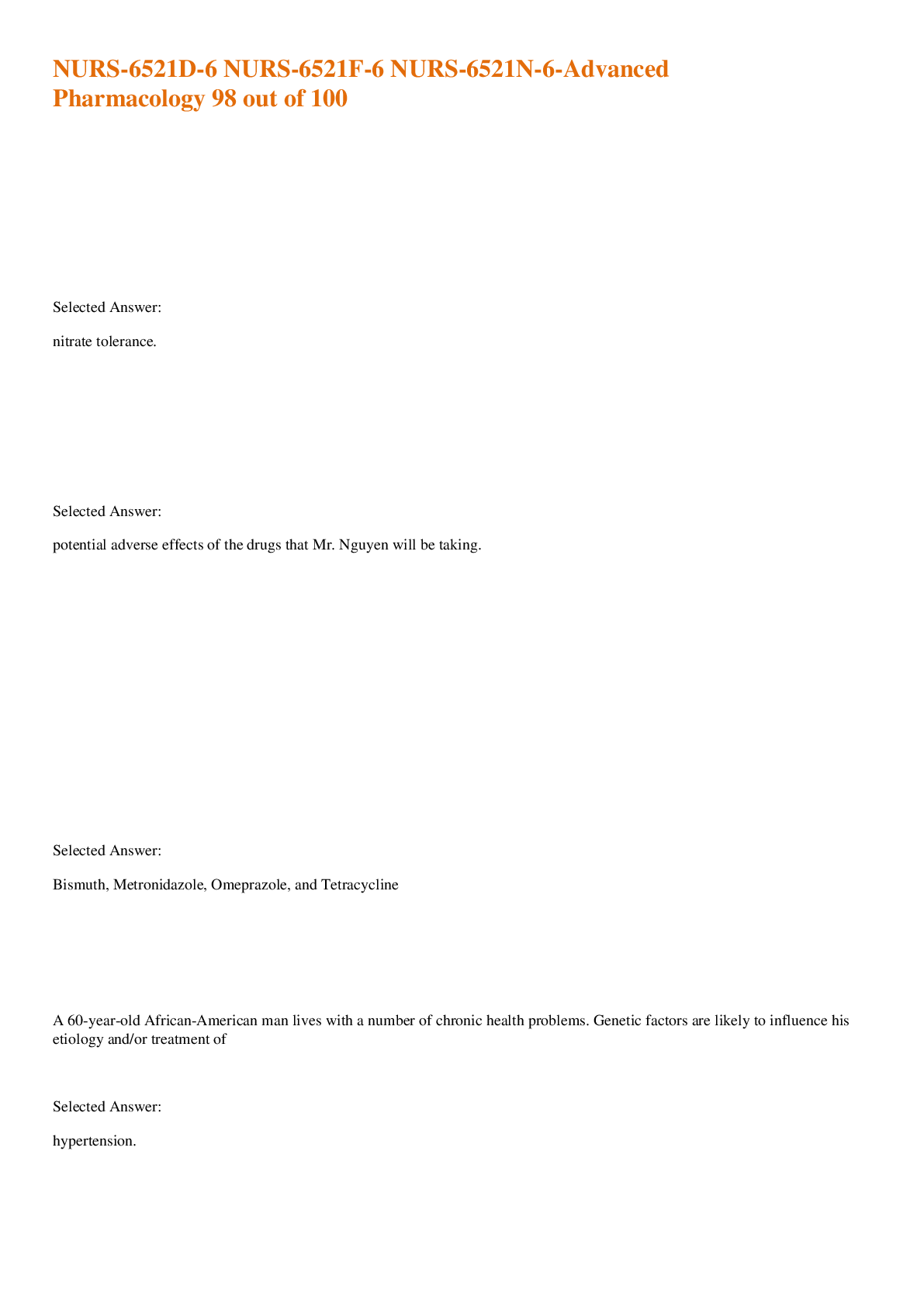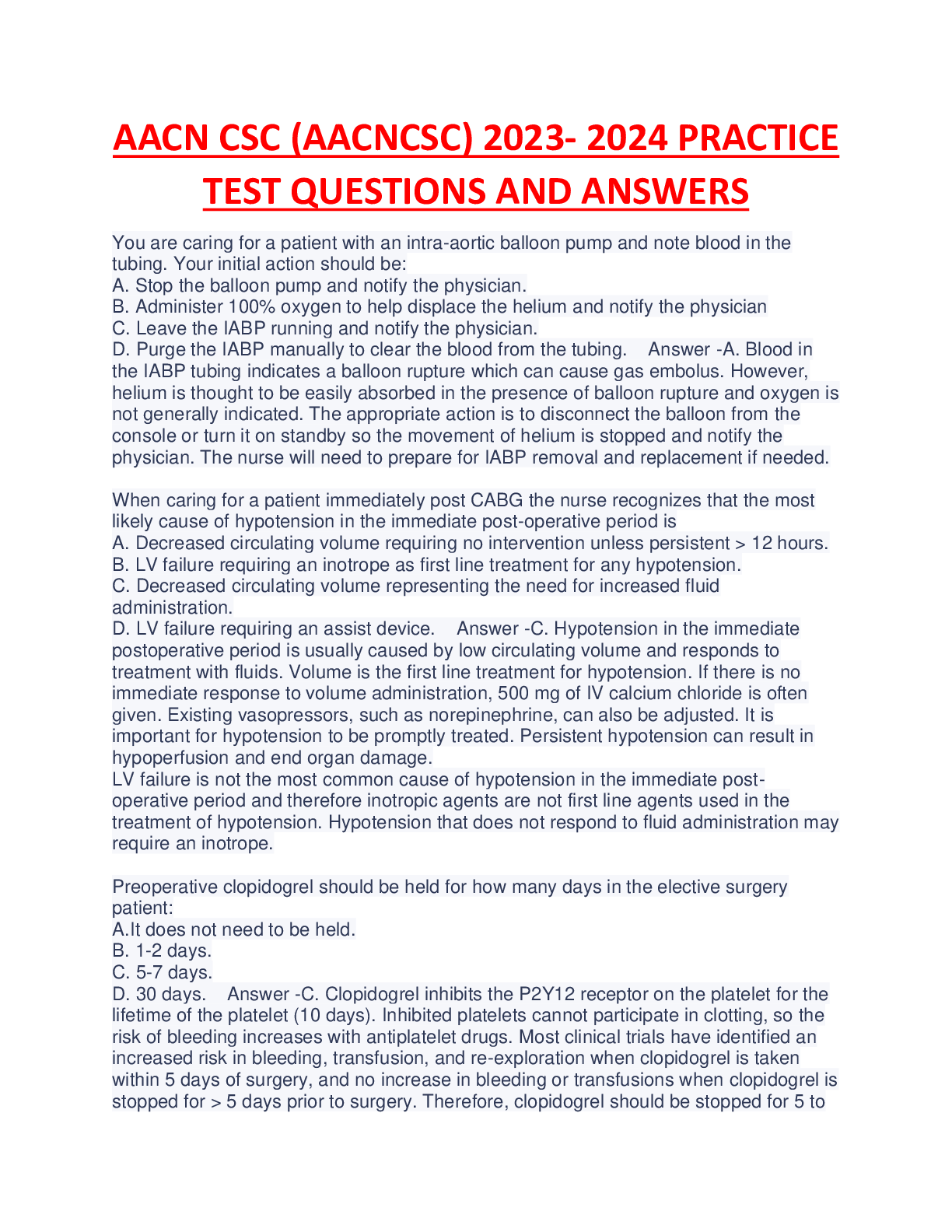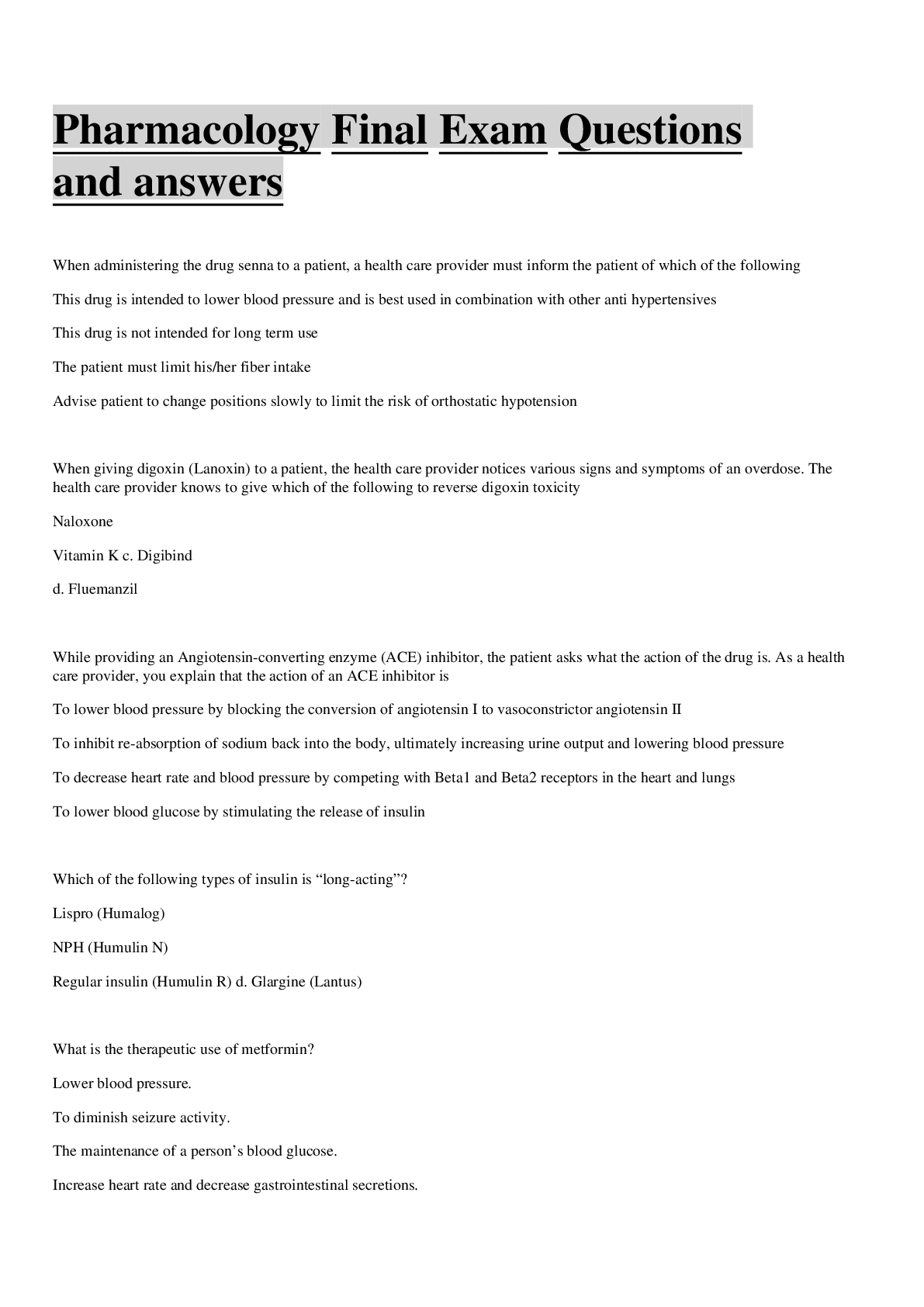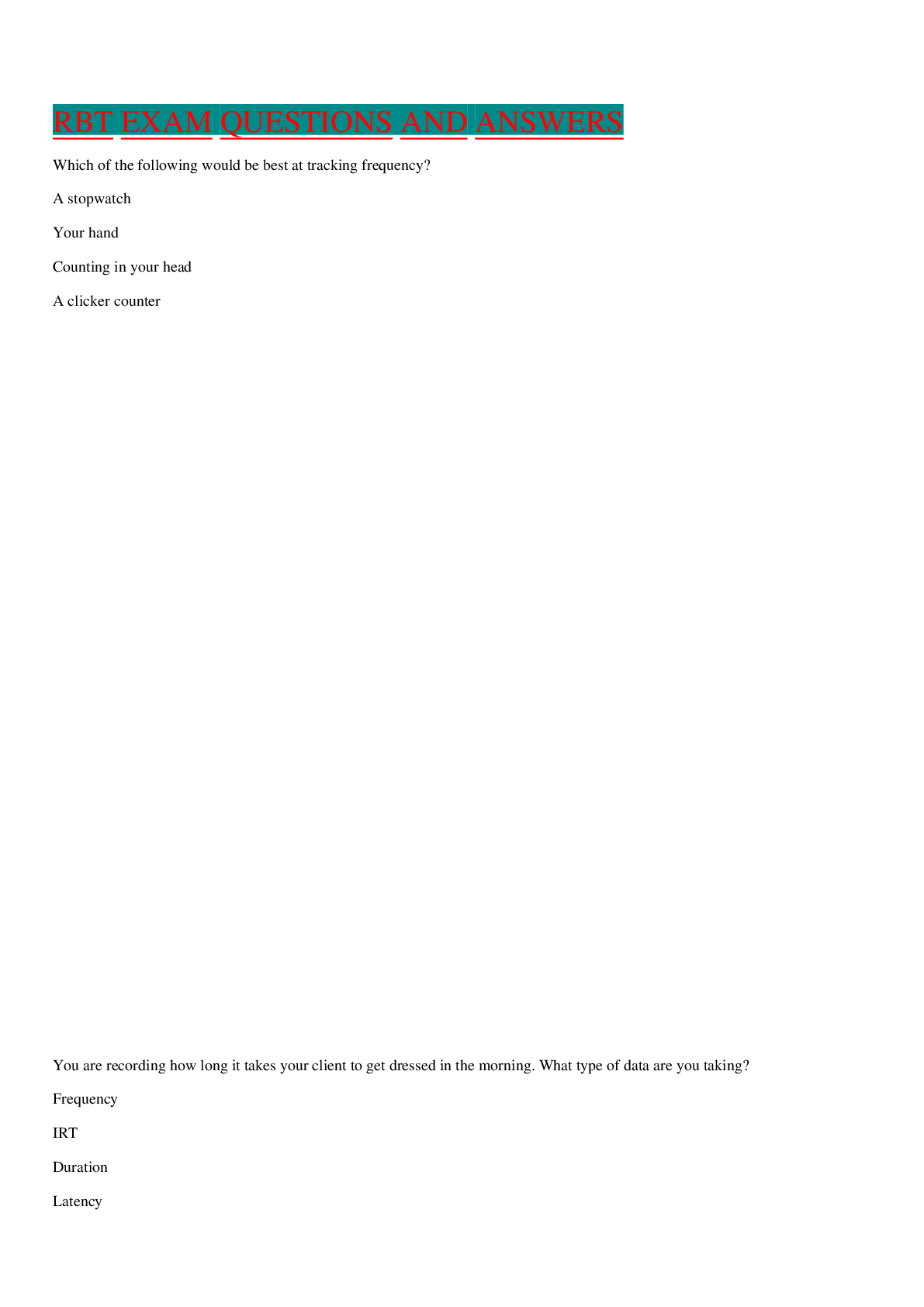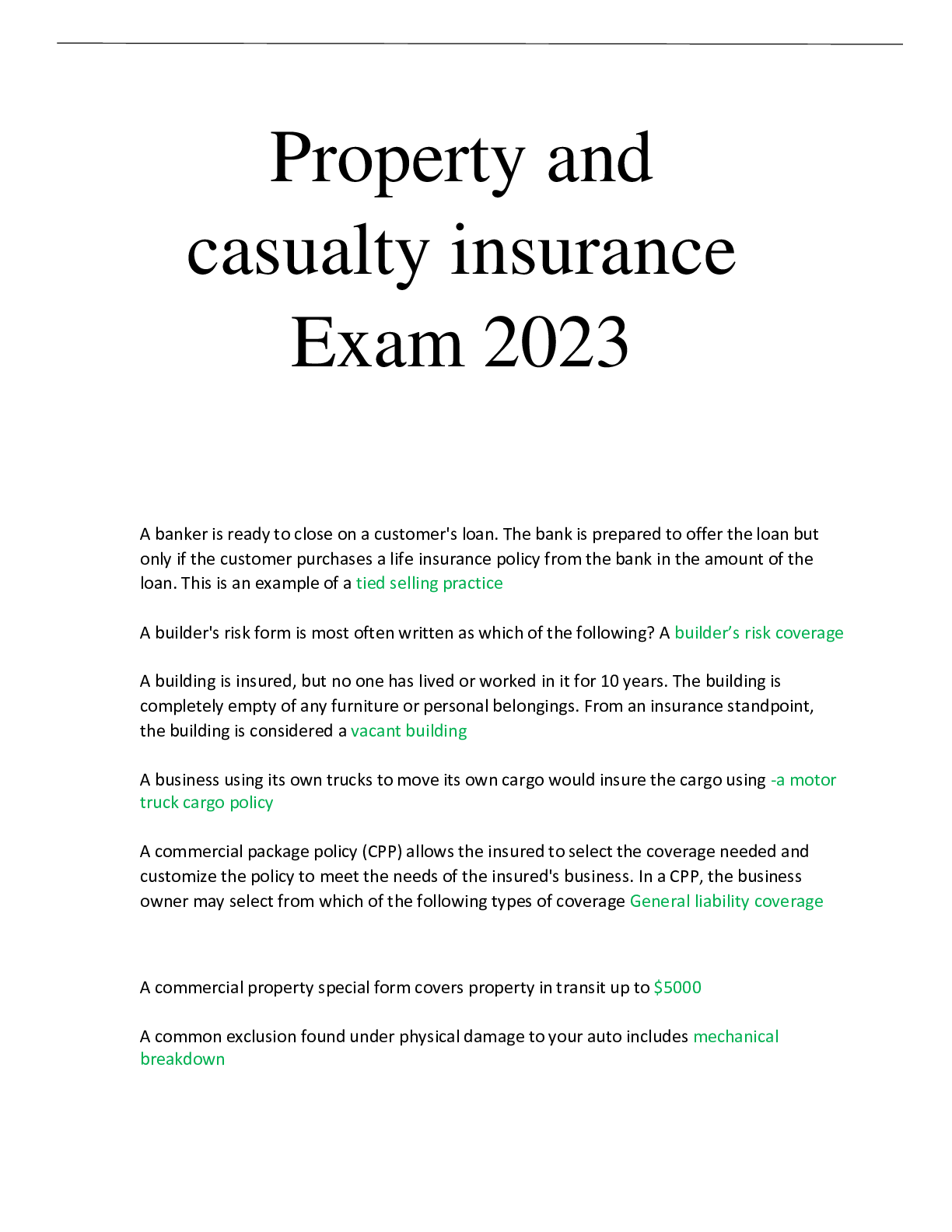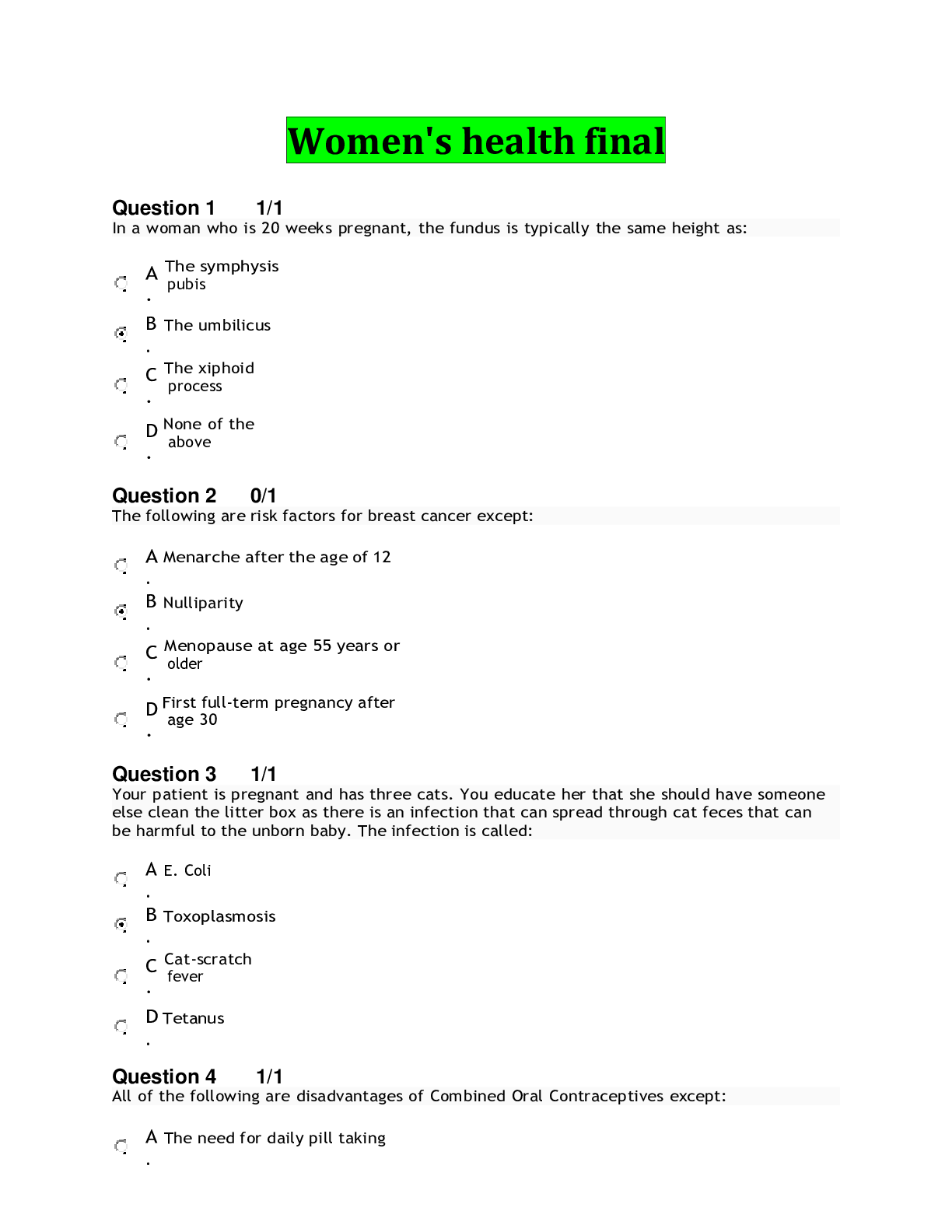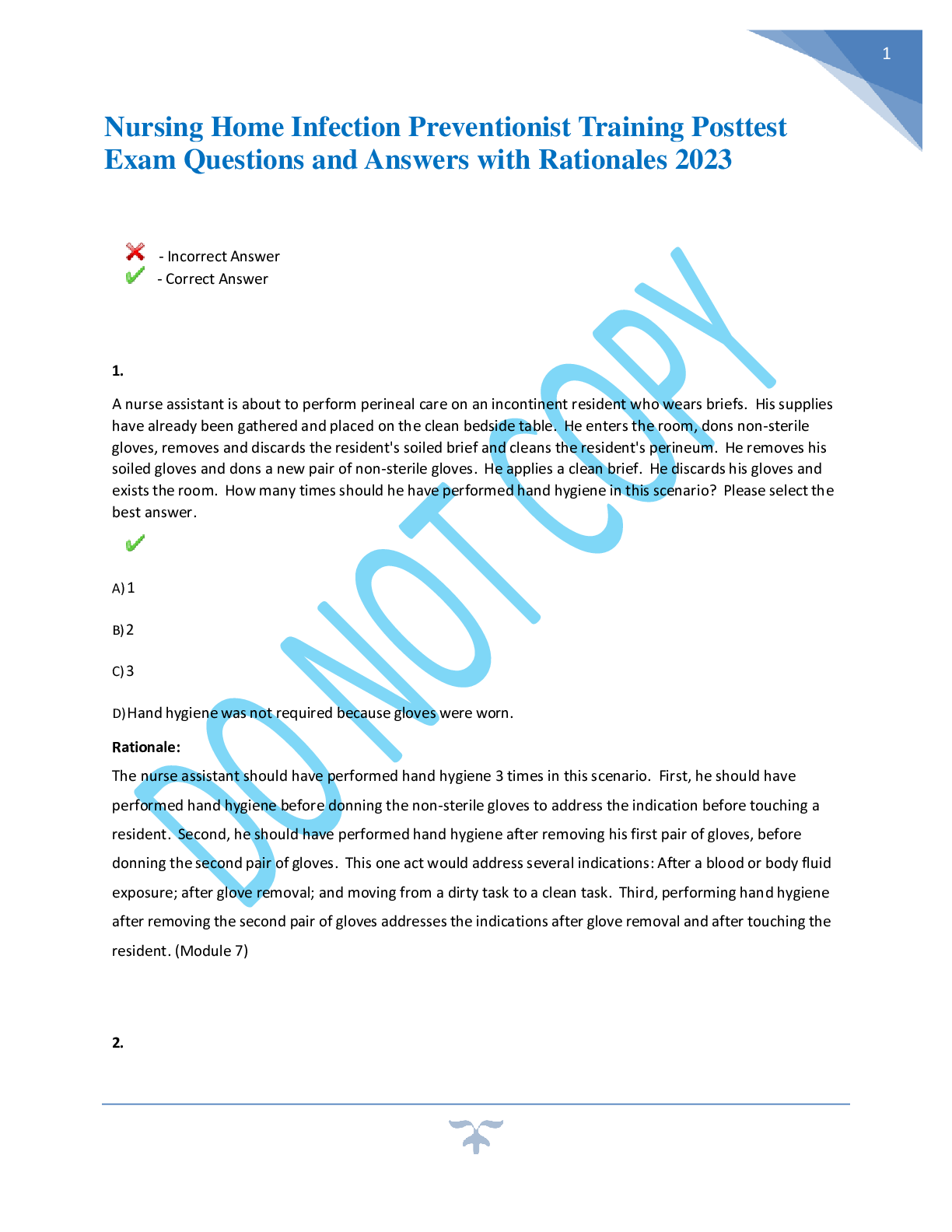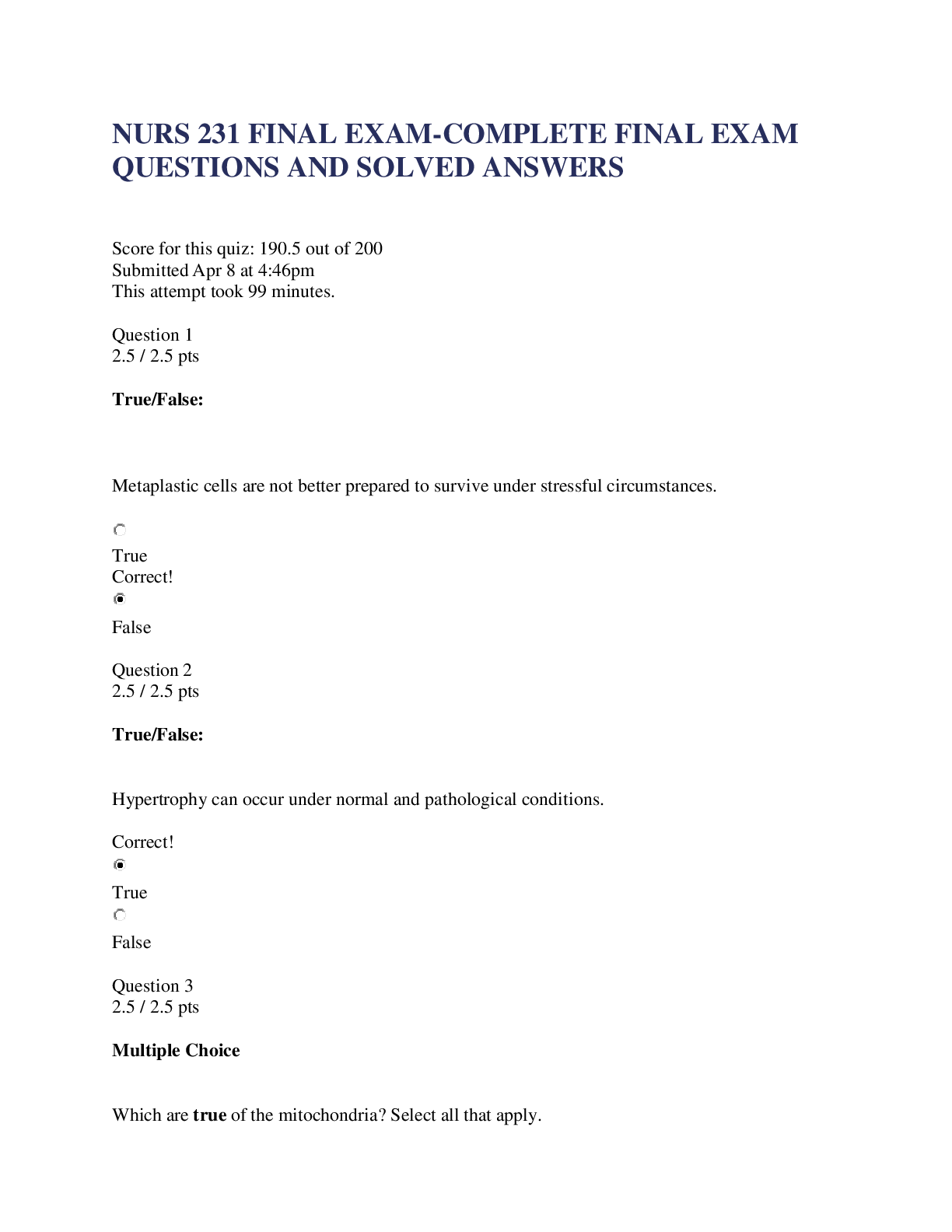NR 509 Week 4 Midterm Exam Questions and Answers 100% Verified
Document Content and Description Below
Question: An 18-year-old patient comes to the office for evaluation of a rash. At first there was only one large patch, but then more lesions … suddenly on the back and torso; the lesions itch. On p... hysical examination, you note that the pattern of eruption is like a Christmas tree and that there are a variety of erythematous papules and macules on the cleavage lines of the back. Based on this description, what is the most likely diagnosis? Question: A 19-year-old construction worker presents for evaluation of a rash. He notes that it … on his back with a multitude of spots and is also on his arms, chest, and neck. It itches a lot. He does sweat more than before because being outdoors is part of his job. On physical examination, you note dark tan patches with a reddish cast that has sharp borders and fine scales, … more prominently around the upper back, chest, neck, and upper arms as well as under the arms. Based on this description, what is your most likely diagnosis? Question: You are examining a child with severe cerebral palsy. When you suddenly move his foot dorsally, a sustained “beating” of the foot against your hand ensues. What does this represent? Question: A patient presents with a daily headache which has … over the past several months. On funduscopic examination, you notice that the disk edge is indistinct and the veins do not pulsate. Which is most likely? Question: A patient complains of epistaxis. Which other cause should … considered? Question: A patient complains of shortness of breath for the past few days. On examination, you note late inspiratory crackles in the lower third of the chest that were not present a week ago. What is the most likely explanation for these? Question: You are … about a positive test finding you have just … on physical examination of your patient. You go on to do more examination, laboratory work, and diagnostic tests, only to find that there is no sign of the disease you thought would correlate with the finding. This same experience happens several times. What should you conclude? Question: A 50-year-old woman presents with a new complaint of headache. The patient states, “this is worst headache of my life”. Her concurrent conditions include hypertension. Her history includes habitual ER visits for various complaints and panic attacks. Her most recent ER visit was last week. Today her BP is 200/110 with a HR of 95. Of the following diagnoses, which etiology has the highest priority? Question: A patient with alcoholism is brought in with confusion. You ask him to “stop traffic” with his palms and notice that every few seconds his palms suddenly move toward the What does this indicate? Question: A 29-year-old computer programmer comes to your office for evaluation of a headache. The tightening sensation is … all over the head and is of moderate It … to last minutes, but this time it has … for 5 days. He denies photophobia and nausea. He spends several hours each day at a computer monitor/keyboard. He has … over-the-counter medication; it has … the pain but not taken it away. Based on this description, what is your most likely diagnosis? Question: A 62-year-old smoker complains of “coughing up small amounts of blood,” so you consider hemoptysis. Which other diagnoses should also … as an etiology for the complaint? Question: You ask a patient to hold her arms up, with her palms up, and then to close her eyes. The right arm begins to move downward after a few seconds and her thumb rotates upward. This is most likely a problem with which part of the nervous system? Question: When assessing for mitral stenosis, you should place the patient in what position? Question: A patient presents with ear pain. She is an avid swimmer. The history includes pain and drainage from the left On examination, she has pain when the ear is manipulated, including manipulation of the tragus. The canal is … and erythematous, with some white debris in the canal. The rest of the examination is normal. What diagnosis would you assign this patient? Question: When assessing for nystagmus the nurse practitioner instructs the patient to: Question: A 58-year-old teacher presents to your clinic with a complaint of breathlessness with The patient has no chronic conditions and does not take any medications, herbs, or supplements. Which of the following symptoms is appropriate to ask about in the cardiovascular review of systems? Question: Which is true of examination of the olfactory nerve? Question: During the physical examination, which is the best position to place the patient when auscultating for S1, S2, and murmurs? Question: For which of the following patients would a comprehensive health history be appropriate? Question: Identify the abnormal assessment findings in this image. Question: A 21-year-old college senior presents to your clinic, complaining of shortness of breath and a nonproductive nocturnal cough. She states she … to feel this way only with extreme exercise, but lately she has felt this way continuously. She denies any other upper respiratory symptoms, chest pain, gastrointestinal symptoms, or urinary tract symptoms. Her past medical history is significant only for seasonal allergies, for which she takes a nasal steroid spray but is otherwise on no other medications. She has had no surgeries. Her mother has allergies and eczema and her father has high blood pressure. She is an only child. She denies smoking and illegal drug use but drinks three to four alcoholic beverages per weekend. She is a junior in finance at a local university and she has recently … a job as a bartender in town. On examination she is in no acute distress and her temperature is 98.6. Her blood pressure is 120/80, her pulse is 80, and her respirations are 20. Her head, eyes, ears, nose, and throat examinations are essentially normal. Inspection of her anterior and posterior chest shows no abnormalities. On auscultation of her chest, there is … air movement and a high-pitched whistling on expiration in all lobes. Percussion reveals resonant lungs. Which disorder of the thorax or lung does this best describe? Question: A patient is … a visual acuity of 20/100 in her left eye. Which of the following is true? Question: While examining a 43-year-old Hispanic female patient, you discover skin findings as represented in this image. She denies history of any known or … adult illnesses or medical conditions. What associated concurrent medical condition should you suspect? Question: Glaucoma is the leading cause of blindness in African-Americans and the second leading cause of blindness overall. What features would be noted on funduscopic examination? Question: A patient is examined with the ophthalmoscope and found to have red reflexes bilaterally. Which of the following diagnoses is still a potential concern? Question: A 7-year-old boy is performing poorly in school. His teacher is … because he is frequently seen “staring off into space” and not paying attention. If this is a seizure, it most likely represents which type? Question: You have just asked a patient how he feels about his emphysema. He becomes silent, folds his arms across his chest and leans back in his chair, and then replies, “It is what it is.” How should you respond? Question: A college student presents with a sore throat, fever, and fatigue for several days. You notice exudates on her enlarged tonsils. You do a careful lymphatic examination and notice some scattered small, mobile lymph nodes just behind her sternocleidomastoid muscles bilaterally. What group of nodes is this? Question: A 55–year-old smoker complains of chest pain and gestures with a closed fist over her sternum to describe it. Which of the following diagnoses should you consider because of her gesture? Question: A 65-year-old woman presents to the clinic with an eye complaint. The medical assistant documents the visual acuity: Corrected right 20/40; Corrected left 20/60; Bilateral 20/60. The nurse practitioner surmises the following: Question: The following information is best placed in which category? “The patient has had three cesarean sections.” Question: A 17-year-old high school student is brought in to your emergency room in a comatose state. His friends have accompanied him and tell you that they have been shooting up heroin tonight and they think their friend may have had too much. The patient is unconscious and cannot protect his airway, so he is intubated. His heart rate is 60 and he is breathing through the ventilator. He is not posturing and he does not respond to a sternal rub. Preparing to finish the neurologic examination, you get a penlight. What size pupils do you expect to see in this comatose patient? Question: T. comes for her regular visit to the clinic. She is on your schedule because her regular provider is on vacation and she … to be seen. You have heard about her many times from your colleague and are aware that she is a very talkative person. Which of the following is a helpful technique to improve the quality of the interview for both the provider and the patient? Question: When using an interpreter to facilitate an interview, where should the interpreter be positioned? Question: The following information is best … in which category? “The patient was … for an asthma exacerbation in the hospital last year; the patient has never been intubated.” Question: Suzanne, a 25 year old, comes to your clinic to establish care. You are the student preparing to go into the examination room to interview Which of the following is the most logical sequence for the patient–provider interview? Question: Which cranial nerve is being … by the examiner in this image? Question: A 32-year-old warehouse worker presents for evaluation of low back pain. He notes a sudden onset of pain after lifting a set of boxes that were heavier than usual. He also states that he has numbness and tingling in the left leg. He wants to know if he needs to be off of work. What test should you perform to assess for a herniated disc? Question: When you enter your patient’s examination room, his wife is waiting there with him. Which of the following is most appropriate? Question: You are testing the biceps strength in a young man following a spinal trauma from a motor vehicle accident. He cannot lift his hand upward, but if the arm is … by the examiner and … to 90 degrees, he can then move his forearm side to side. This would represent which muscle strength grading? Question: Alexandra is a 28-year-old editor who presents to the clinic with abdominal pain. The pain is a dull ache, located in the right upper quadrant, that she rates as a 3 at the least and an 8 at the worst. The pain … a few weeks ago, it lasts for 2 to 3 hours at a time, it comes and goes, and it seems to be worse a couple of hours after eating. She has … that it starts after eating greasy foods, so she has cut down on these as much as she can. Initially it … once a week, but now it is occurring every other Nothing makes it better. From this description, which of the seven attributes of a symptom has been omitted? Question: A 15-year-old high school sophomore comes to the clinic for evaluation of a 3-week history of sneezing; itchy, watery eyes; clear nasal discharge; ear pain; and nonproductive cough. Which is the most likely pathologic process? Question: What is responsible for the inspiratory splitting of S2? Question: A 19-year-old college sophomore comes to the clinic for evaluation of joint pains. The student has been back from spring break for 2 weeks; during her holiday, she went camping. She notes that she had a red spot, shaped like a target, but then it … spreading, and then the joint pains started. She … insect repellant but was in an area known to have ticks. She has never been sick and takes no medications routinely; she has never been sexually active. What is the most likely cause of her joint pain? Question: You are performing a cranial nerve assessment of a 28-year-old female. She denies history of head injury or trauma. However, she has been … in the past year for Lyme Damage or inflammation of which of the following cranial nerves is … in this image? Question: The components of the health history include all of the following except which one? Question: Sudden, painful unilateral loss of vision may … by which of the following conditions? Question: Mark is a contractor who recently … his back. He was told he had a “bulging disc” to account for the burning pain down his right leg and slight foot drop. The vertebral bodies of the spine involve which type of joint? Question: You are interviewing an elderly woman in the ambulatory setting and trying to get more information about her urinary symptoms. Which of the following techniques is not a component of adaptive questioning? Question: Which of the following anatomic landmark associations is correct? Question: Common or concerning symptoms to inquire about in the Constitutional portion of the Review of Symptoms include all of the following except: Question: You are conducting a mental status examination and note impairment of speech and judgement, but the rest of your examination is intact. Where is the most likely location of the problem? Question: A 55-year-old bookkeeper comes to your office for a routine visit. You note that on a previous visit for treatment of contact dermatitis, her blood pressure was elevated. She does not have prior … readings and her family history is negative for hypertension. You measure her blood pressure in your office Which of the following factors can result in a false high reading? Question: Which of the following findings are indicative of respiratory distress? Question: The following information is … in the comprehensive health history for a patient who is establishing care and has no … concerns: “Patient denies chest pain, palpitations, orthopnea, and paroxysmal nocturnal dyspnea.” Which category does it belong to? Question: A young woman undergoes cranial nerve testing. On touching the soft palate, her uvula deviates to the left. Which of the following is likely? Question: A 35-year-old archaeologist comes to your office (located in Phoenix, Arizona) for a regular skin check-up. She has just … from her annual dig site in Greece. She has fair skin and reddish-blonde hair. She has a family history of melanoma. She has many freckles … across her skin. From this description, which of the following is not a risk factor for melanoma in this patient? Question: A 15-year-old high school sophomore presents to the emergency room with his mother for evaluation of an area of blood in the left eye. He denies trauma or injury but has been coughing forcefully with a recent cold. He denies visual disturbances, eye pain, or discharge from the eye. On physical examination, the pupils are equal, round, and reactive to light, with a visual acuity of 20/20 in each eye and 20/20 bilaterally. There is a homogeneous, sharply … area at the lateral aspect of the base of the left eye. The cornea is clear. Based on this description, what is the most likely diagnosis? Question: A 47-year-old contractor presents for evaluation of neck pain, which has been intermittent for several years. He normally takes over-the-counter medications to ease the pain, but this time they haven’t … as well and he still has discomfort. He recently … the entire second floor in his house, which … him great discomfort. The pain … with rest. He denies fever, chills, rash, upper respiratory symptoms, trauma, or injury to the neck. Based on this description, what is the most likely pathologic process? Question: The following information is … in the health history: “The patient … 8th grade. He currently lives with his wife and two children. He works on old cars on the weekend. He works in a glass factory during the week.” Which category does it belong to? Question: Fields is a pleasant, obese female with a BMI of 39. BP 120/82, HR 80, R 18, Oxygen Saturation 98%. This information is: Question: Two weeks ago, Mary … a job which requires carrying 40-pound buckets. She presents with elbow pain worse on the right. On examination, it hurts her elbows to dorsiflex her hands against resistance when her palms face the What condition does she have? TENNISELBOW Question: A 43-year-old female patient presents with concern about her skin lightening over the past 3 months. The findings are … in this image. She denies recent illness or infection. Her physical examination is otherwise unremarkable. Which laboratory study is most important to include with her work-up? Question: Tommie, a 48-year-old African American contractor, reports pain of the right great toe. “Feels like a ton of bricks fell on my foot”. The pain extends up his legs. This information is: Question: The nurse practitioner is assessing a patient’s chief complaint of shoulder pain that … about 3 weeks ago. Upon physical exam, findings reveal atrophy of the supraspinatus and … prominence of the scapular spine, pain with shoulder movement, and a positive drop arm test. The most likely diagnosis for these findings is: Question: Common or concerning symptoms to inquire about during the constitutional survey of the ROS include all of the following EXCEPT: Question: A young man comes to you with an extremely pruritic rash over his knees and elbows which has come and gone for several years. It seems to be worse in the winter and improves with some sun exposure. On examination, you notice scabbing and crusting with some silvery scale, and you are observant enough to notice small “pits” in his nails. What would account for these findings?*SILVER* Question: You are conducting a physical examination on an 82-year-old male patient. You lift his shirt and discover skin lesions as … in this image. What is your immediate next course of action? Question: Jason is a 41-year-old electrician who presents to the clinic for evaluation of shortness of breath. The shortness of breath occurs with exertion and improves with rest. It has been going on for several months and initially … only a couple of times a day with strenuous exertion; however, it has … to occur with minimal exertion and is happening more than a dozen times per The shortness of breath lasts for less than 5 minutes at a time. He has no cough, chest pressure, chest pain, swelling in his feet, palpitations, orthopnea, or paroxysmal nocturnal dyspnea. Which of the following symptom attributes was not … in this description? Question: A 38-year-old woman comes to you and has multiple small joints … with pain, swelling, and stiffness. Which of the following is the most likely explanation? *Multiple small joints* gout is one Question: You examine a “sleepy” patient. You note that she will open her eyes and look at you but responds slowly and is confused. She does not appear … in her surroundings. How would you describe her level of consciousness? Question: In this image, what test is being performed? [Show More]
Last updated: 1 year ago
Preview 1 out of 37 pages
Reviews( 0 )
Document information
Connected school, study & course
About the document
Uploaded On
Mar 26, 2022
Number of pages
37
Written in
Additional information
This document has been written for:
Uploaded
Mar 26, 2022
Downloads
0
Views
38

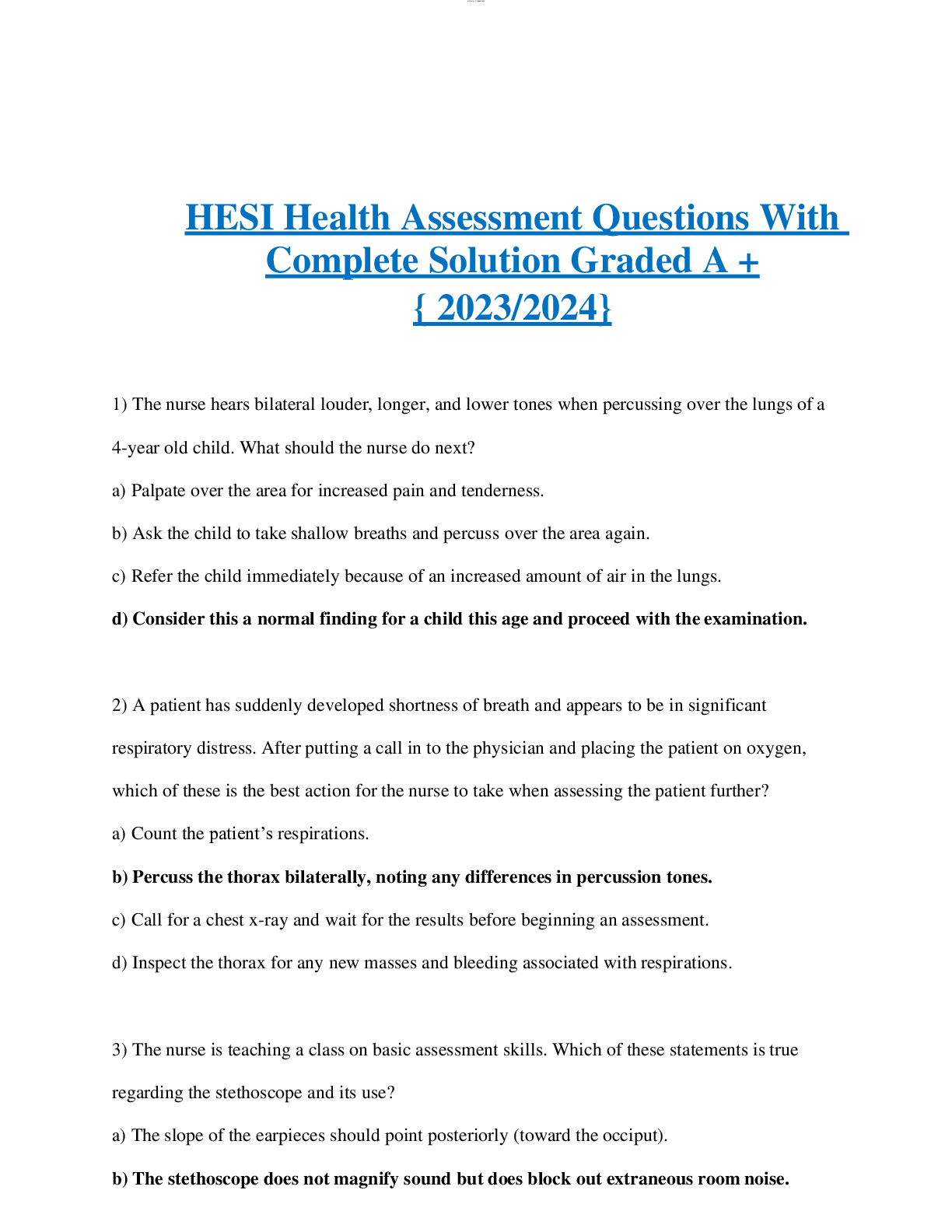
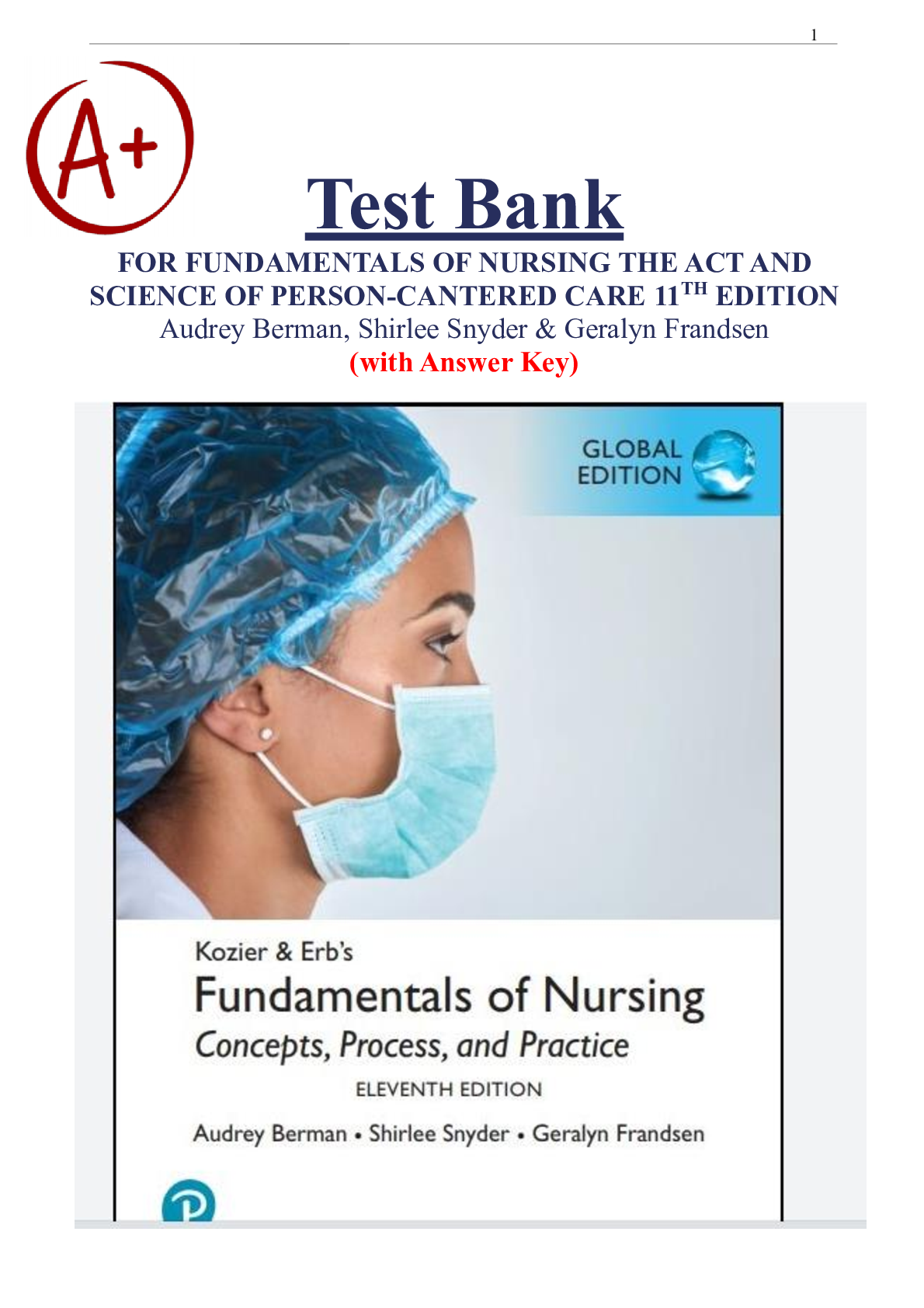
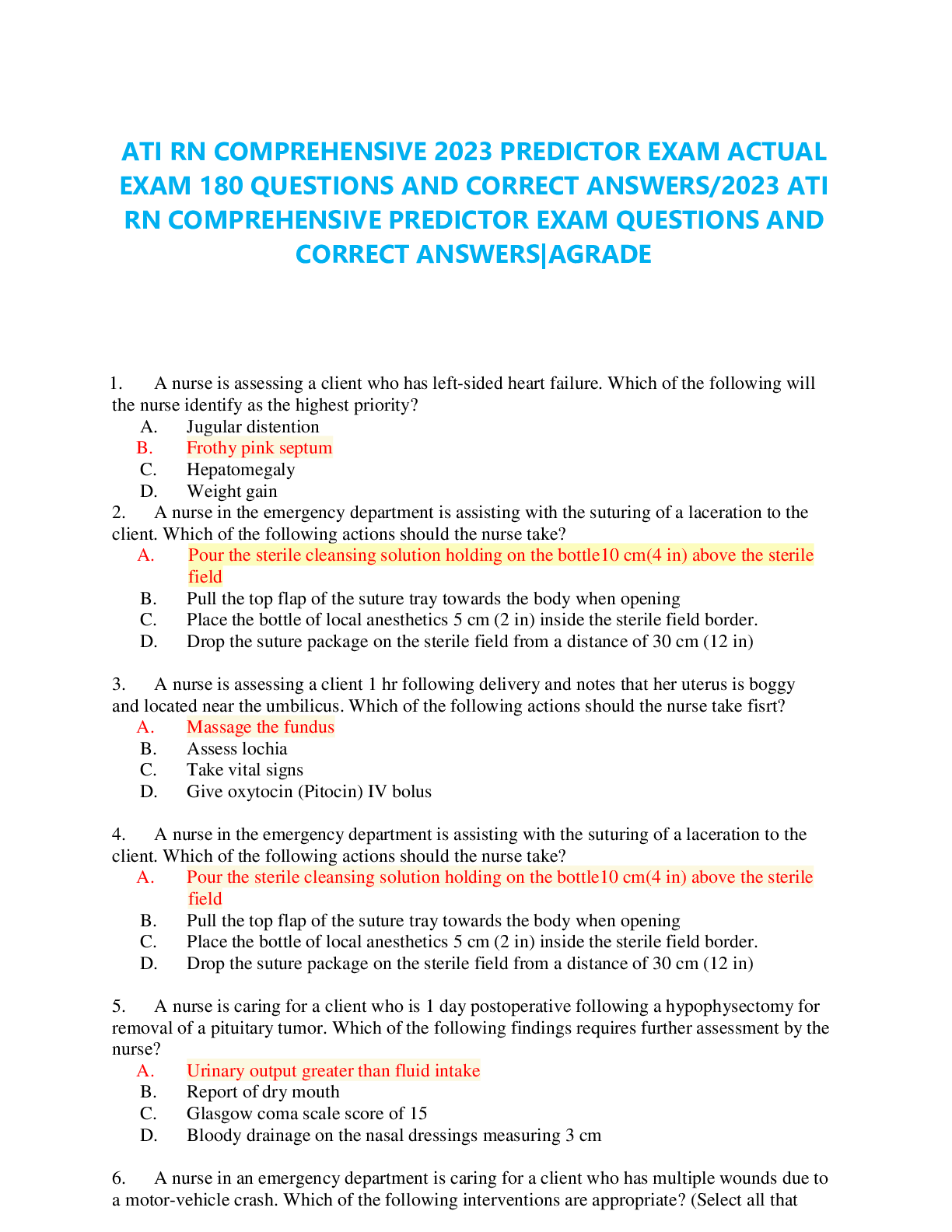
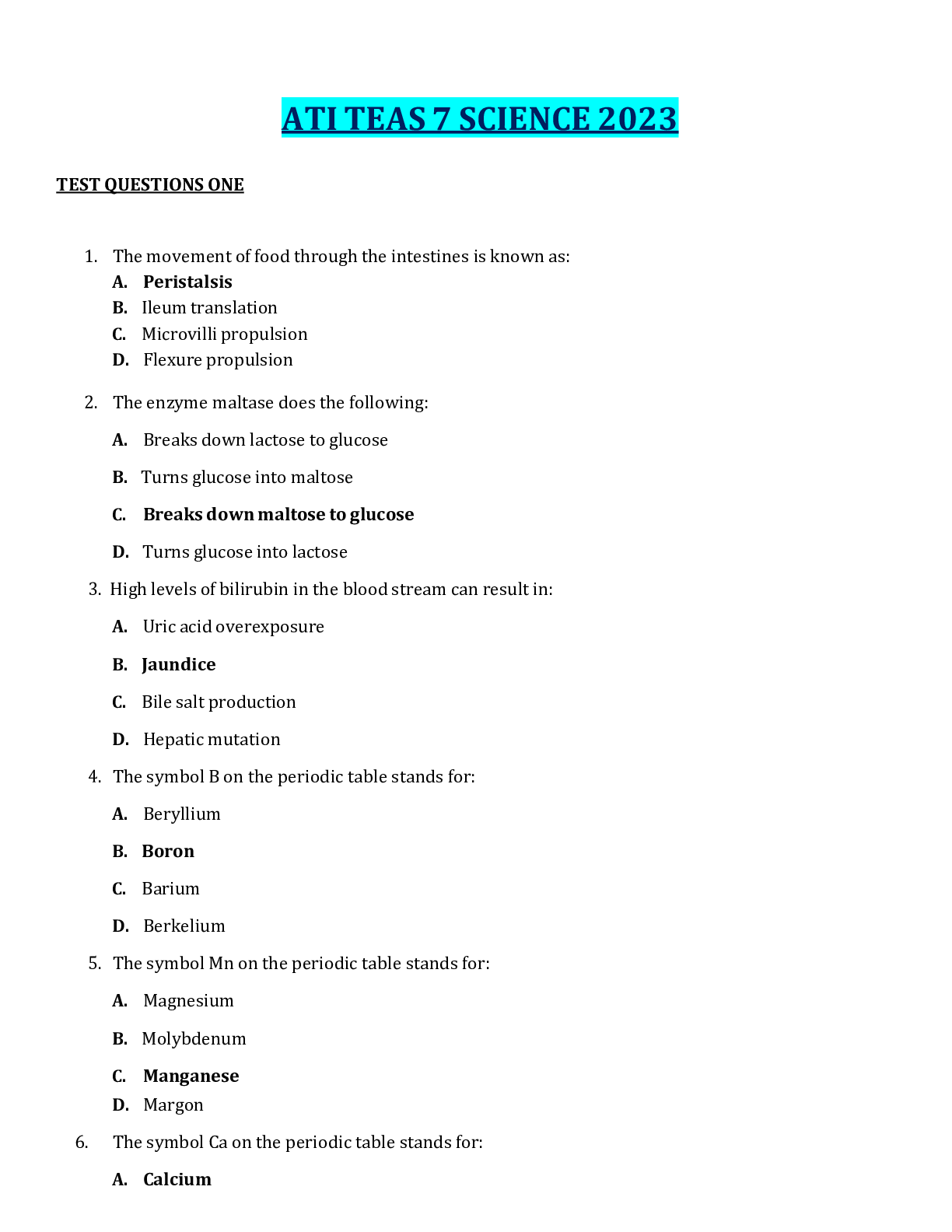
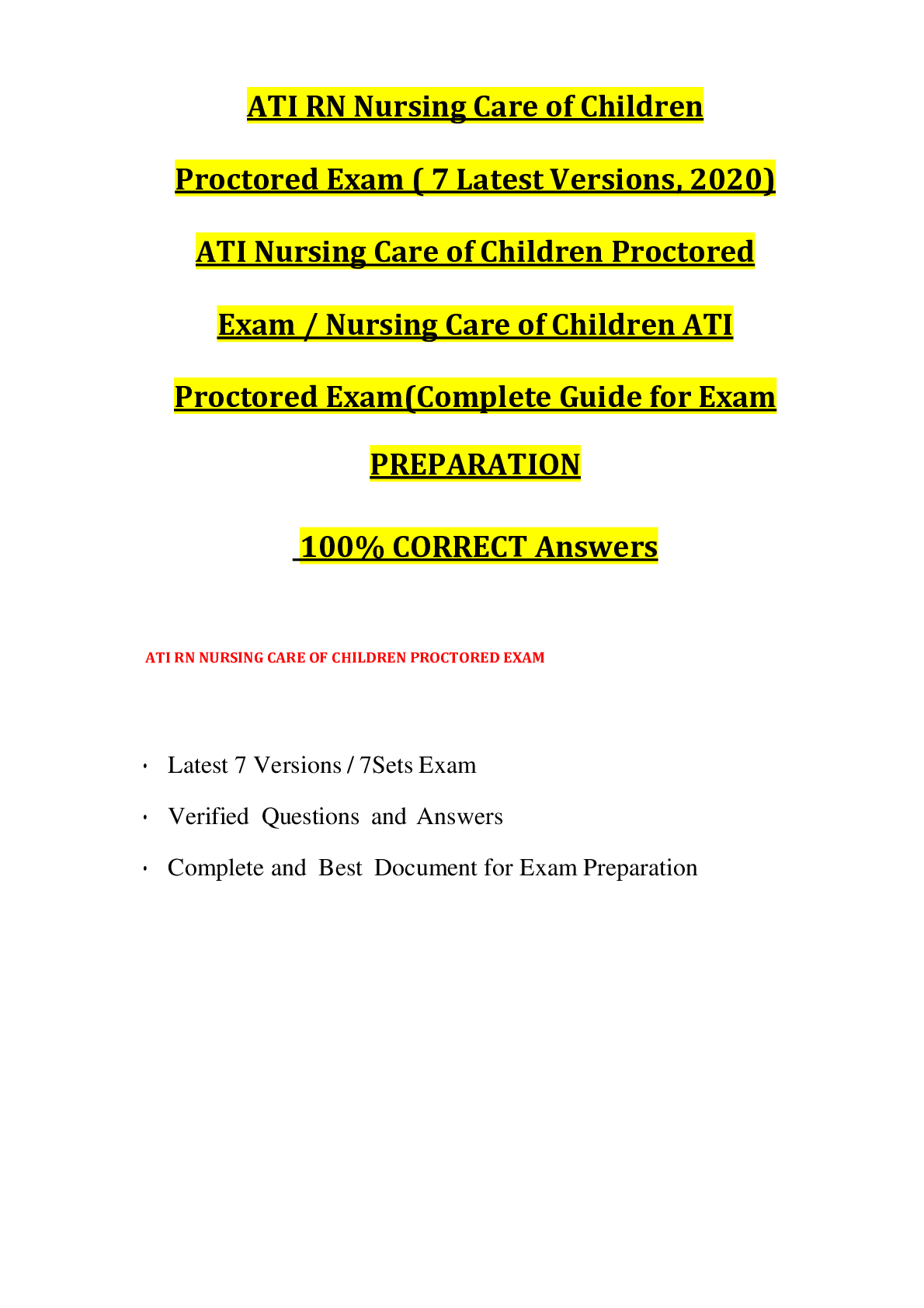
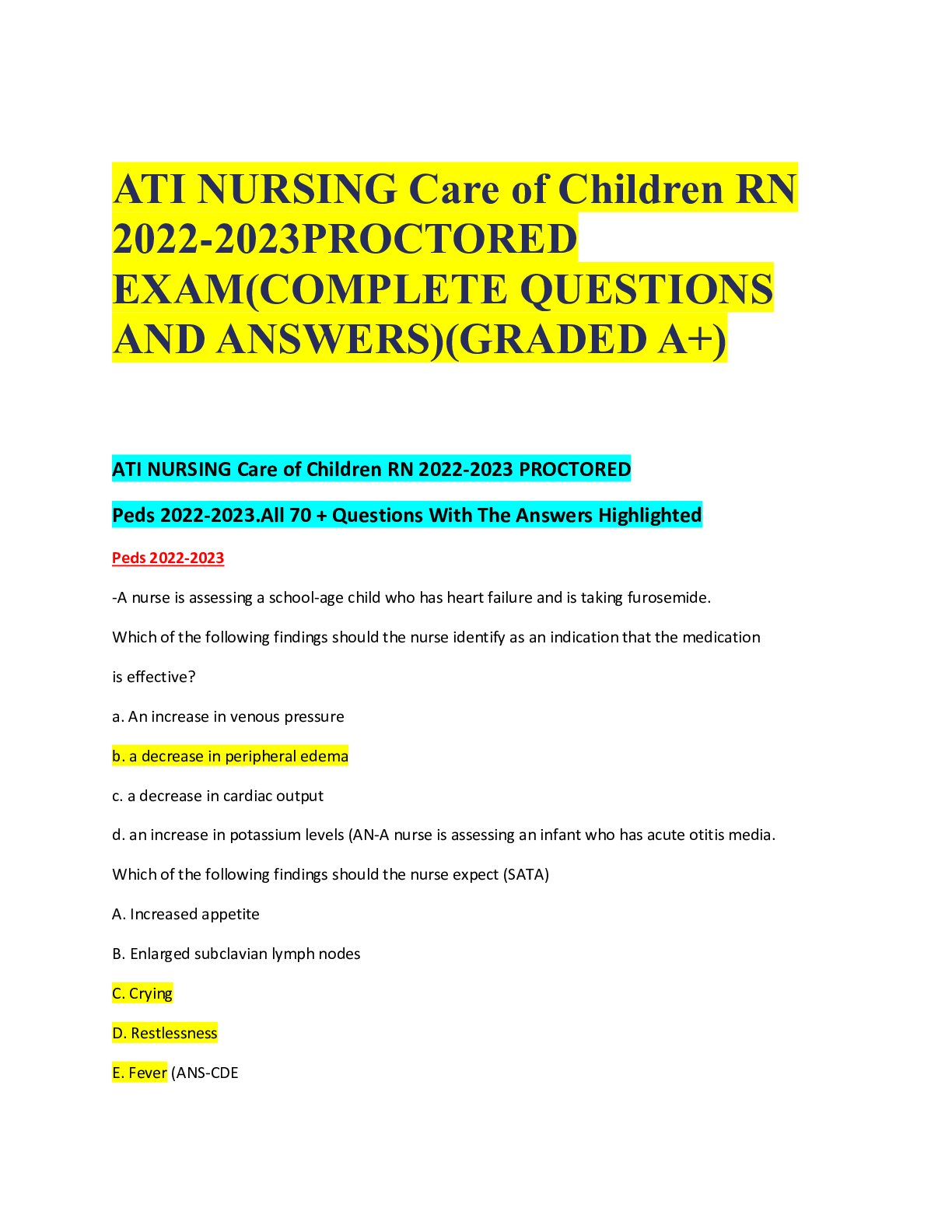
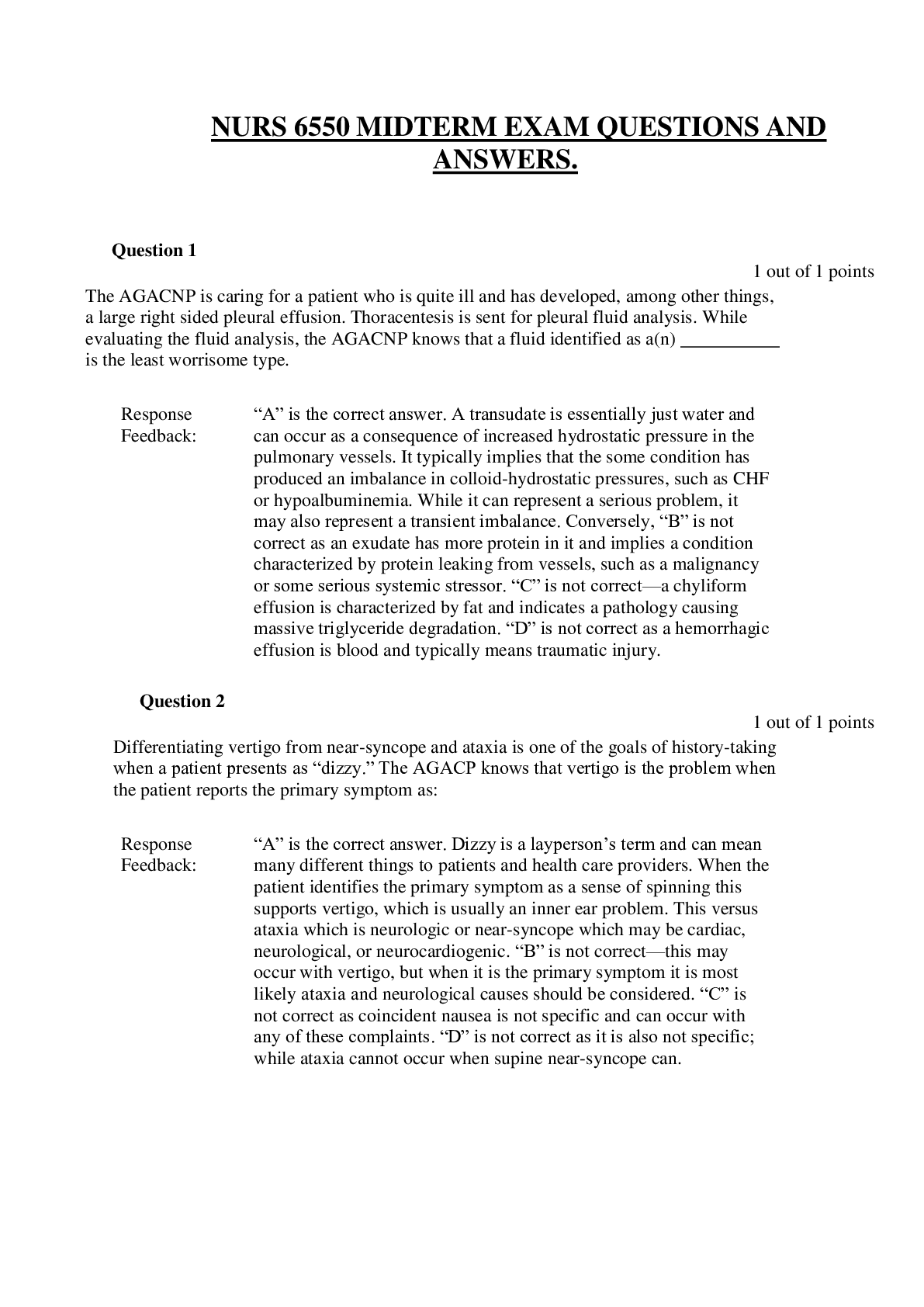

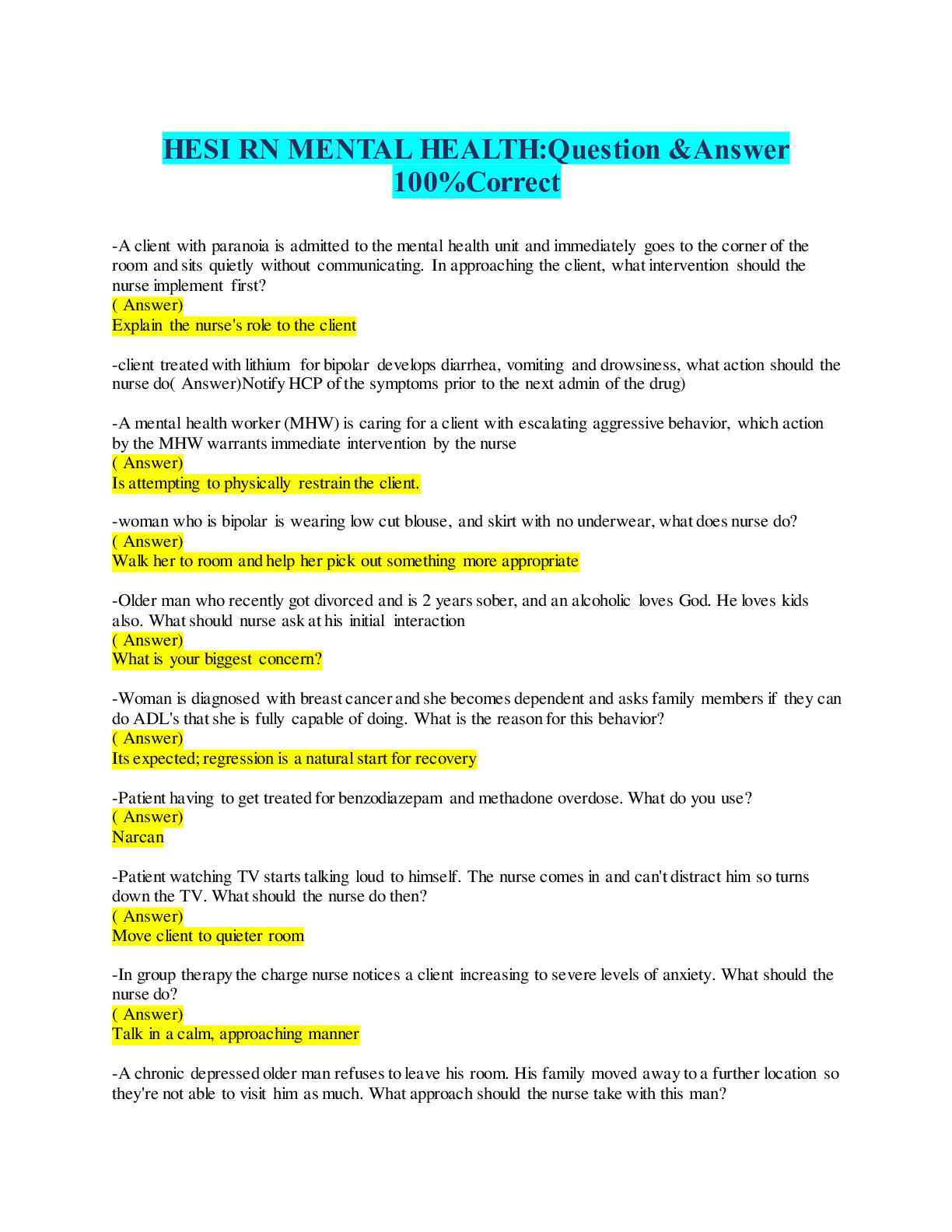
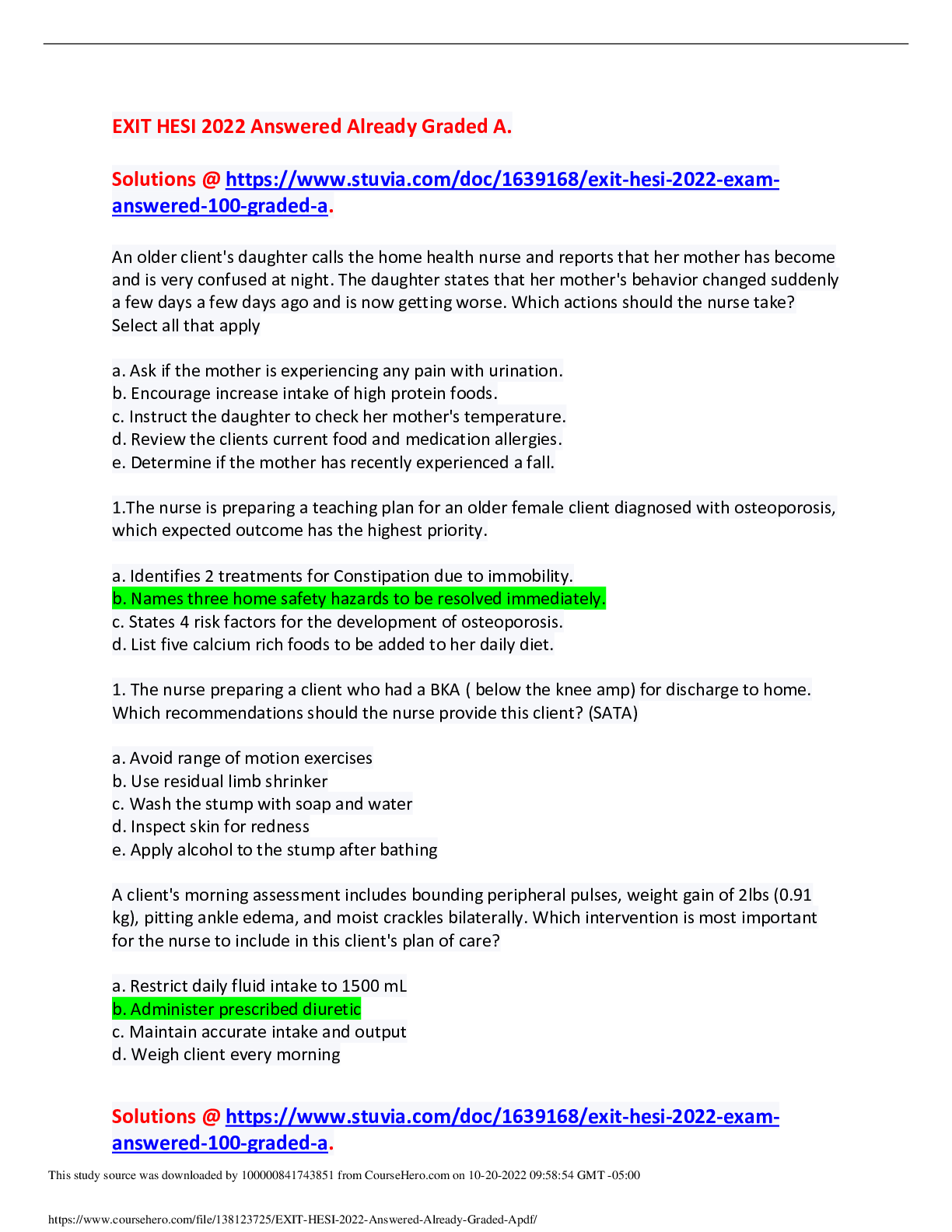
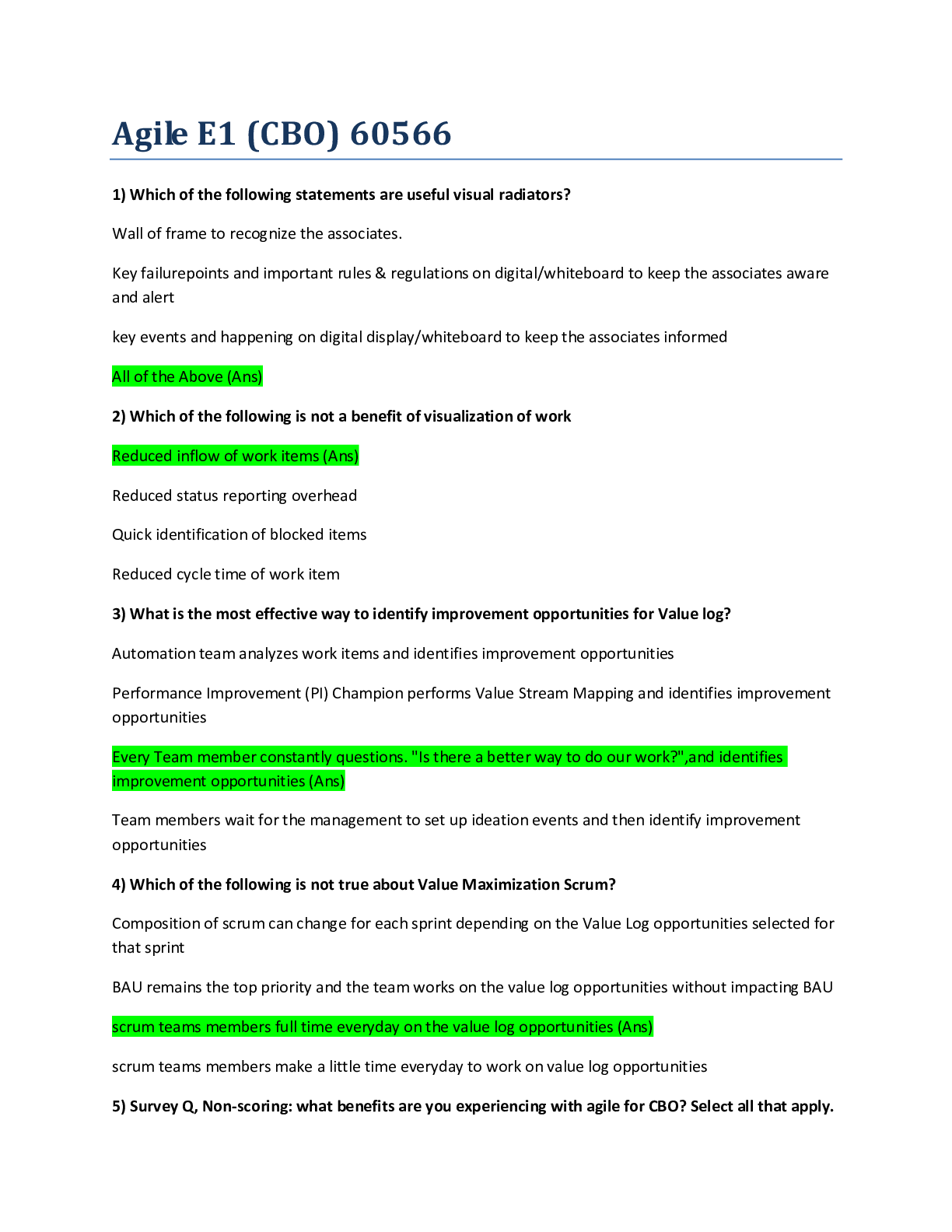
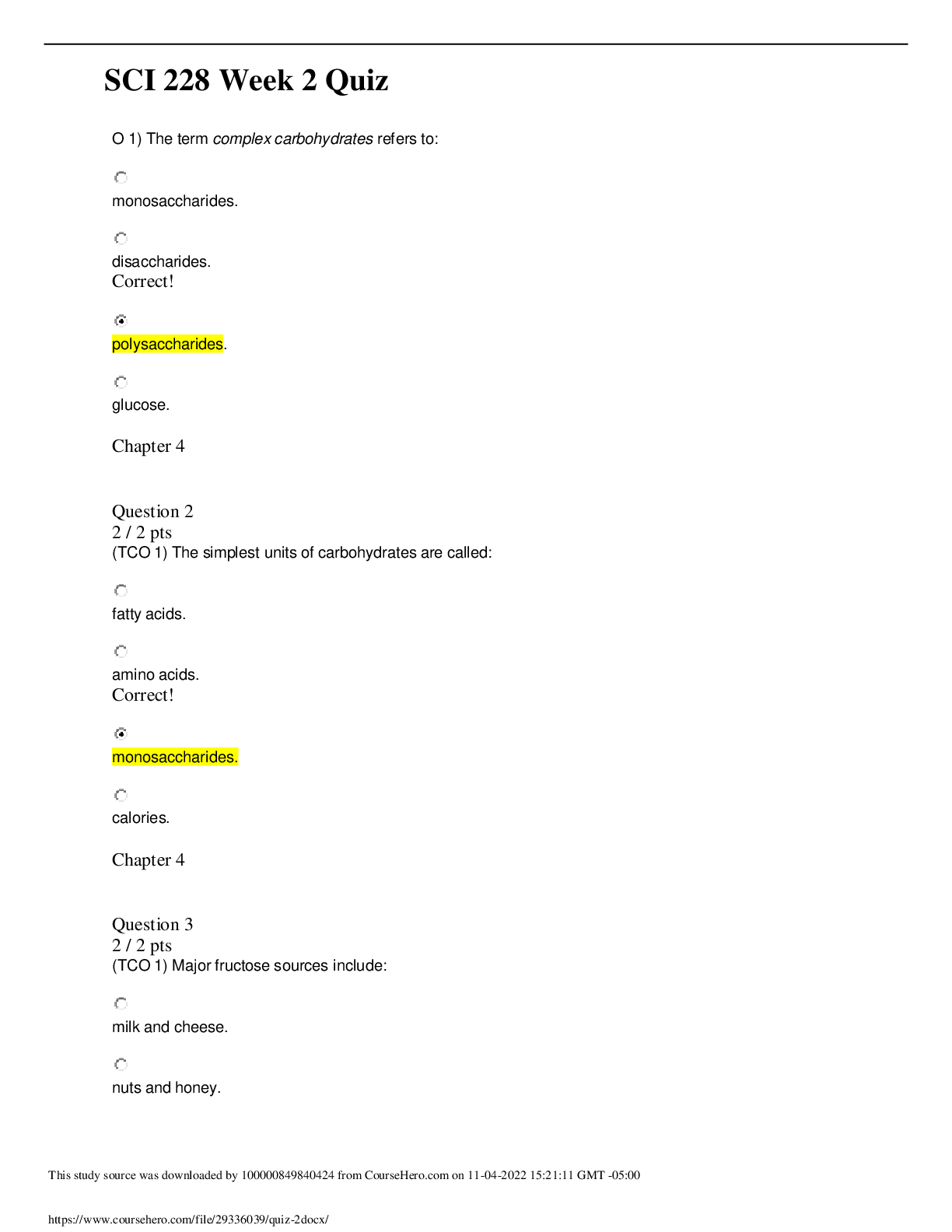
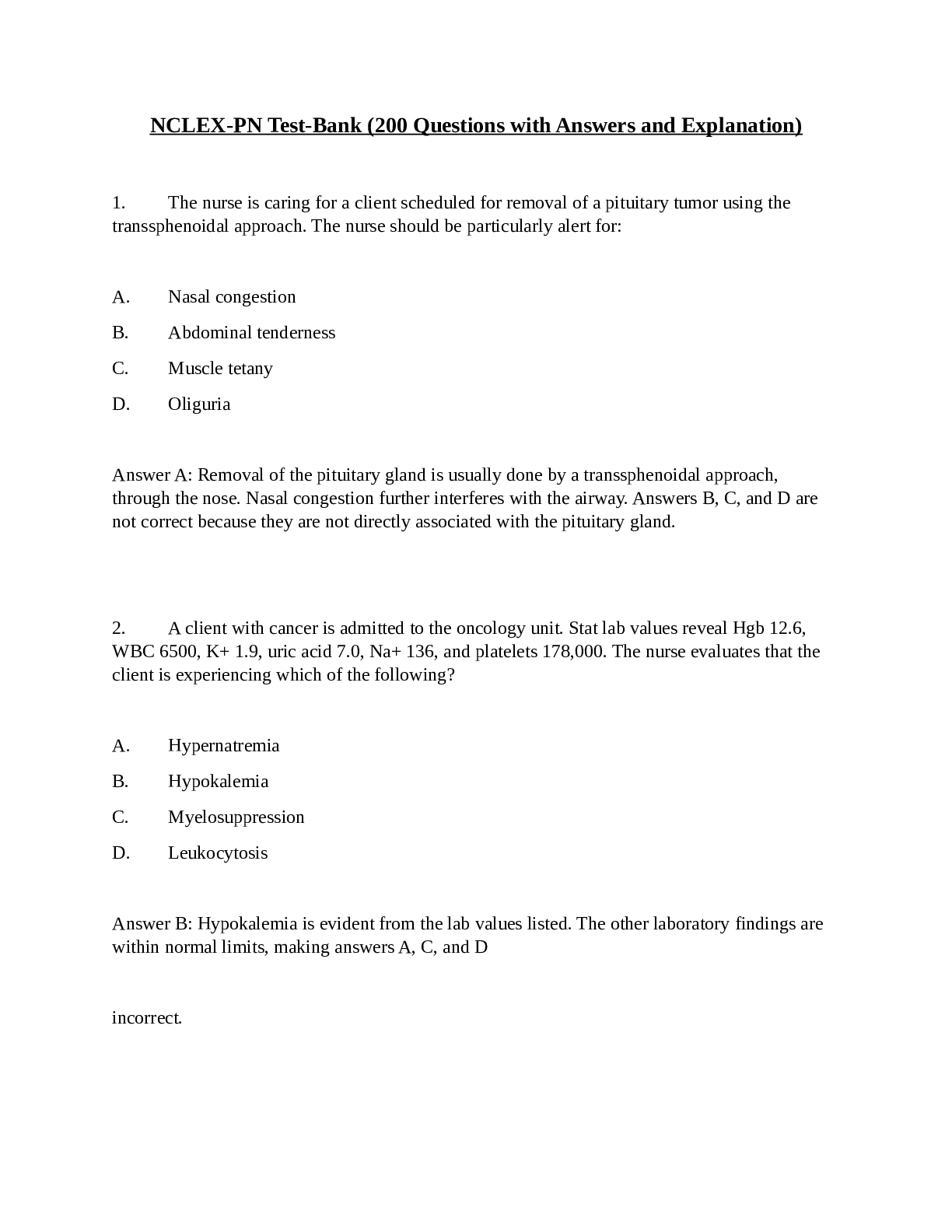
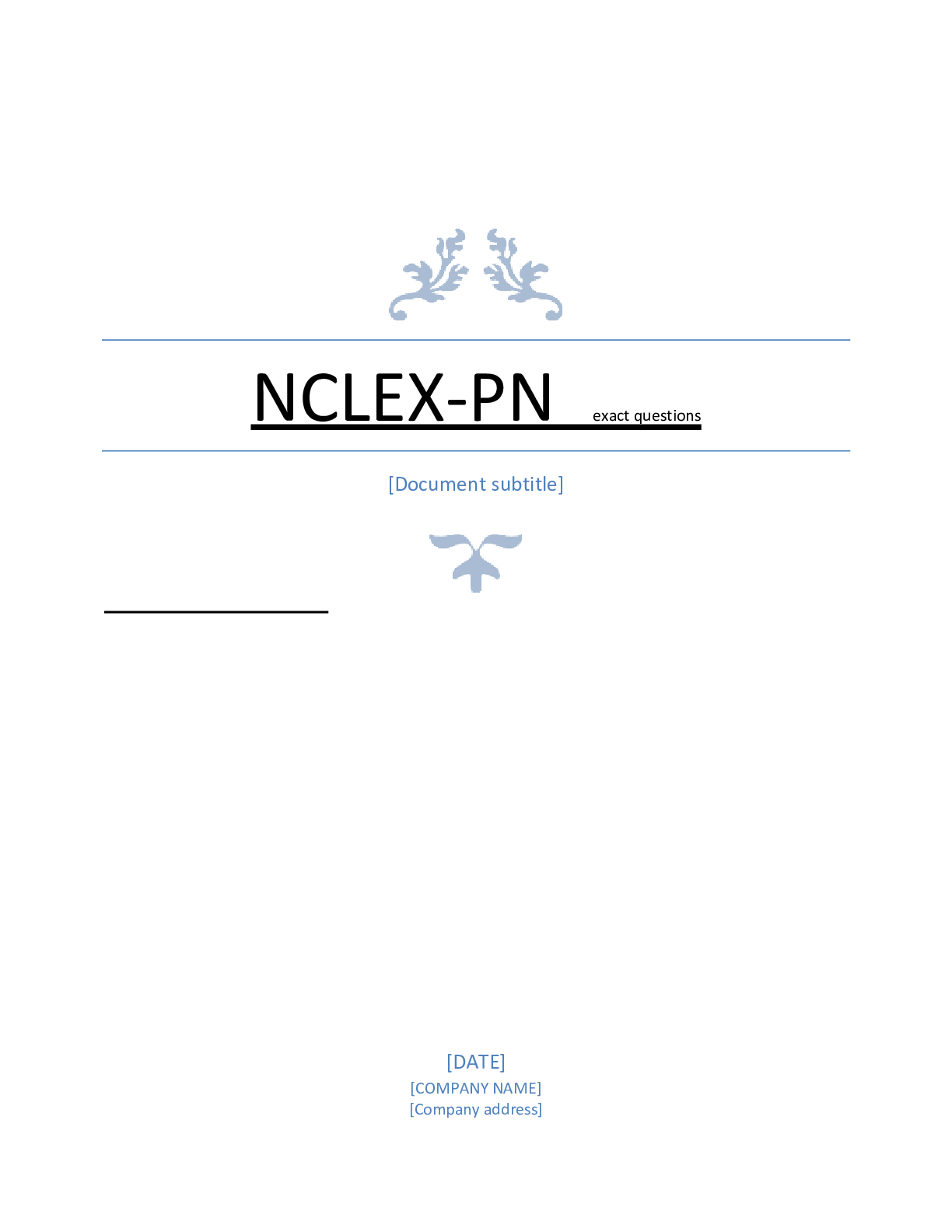
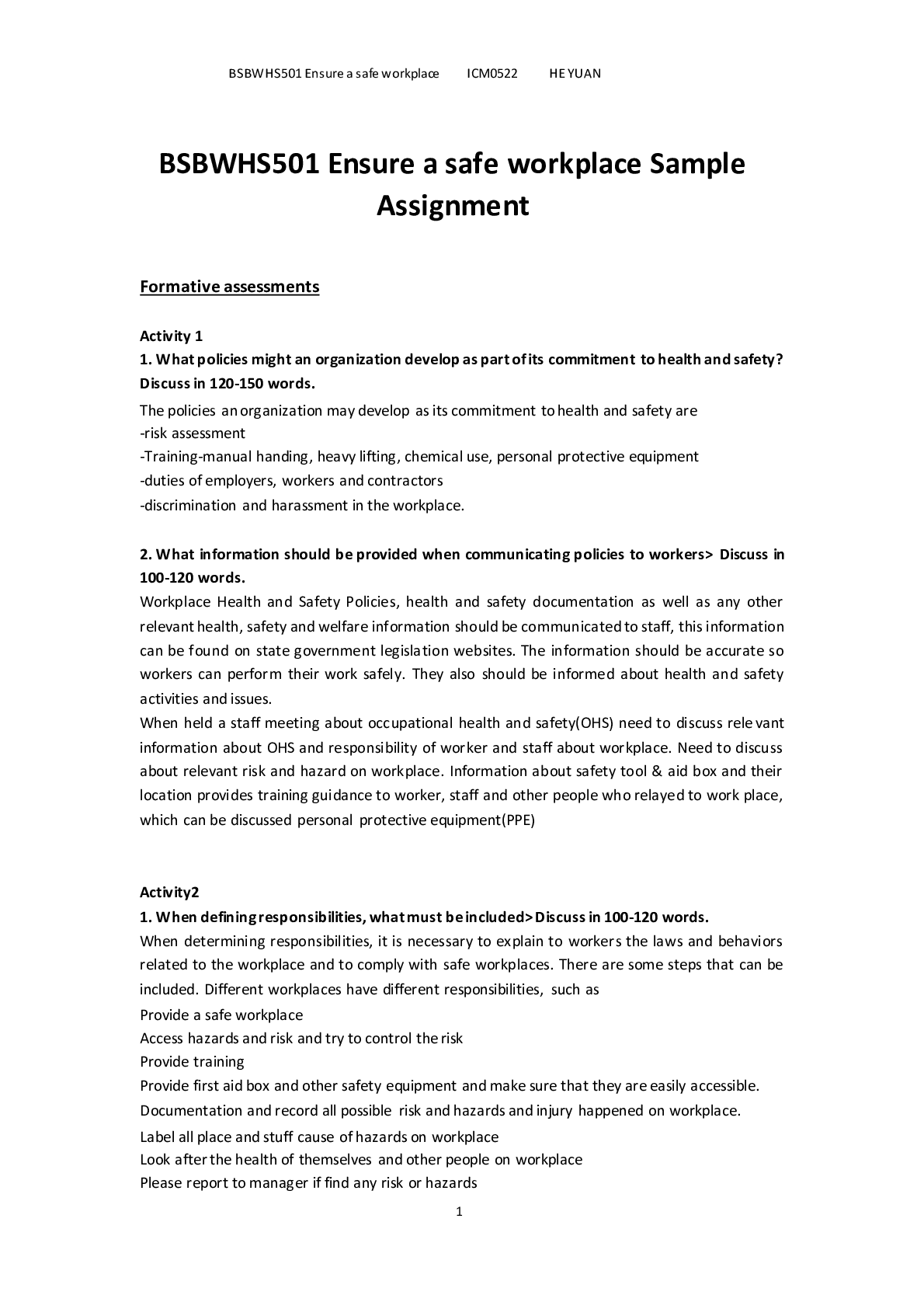
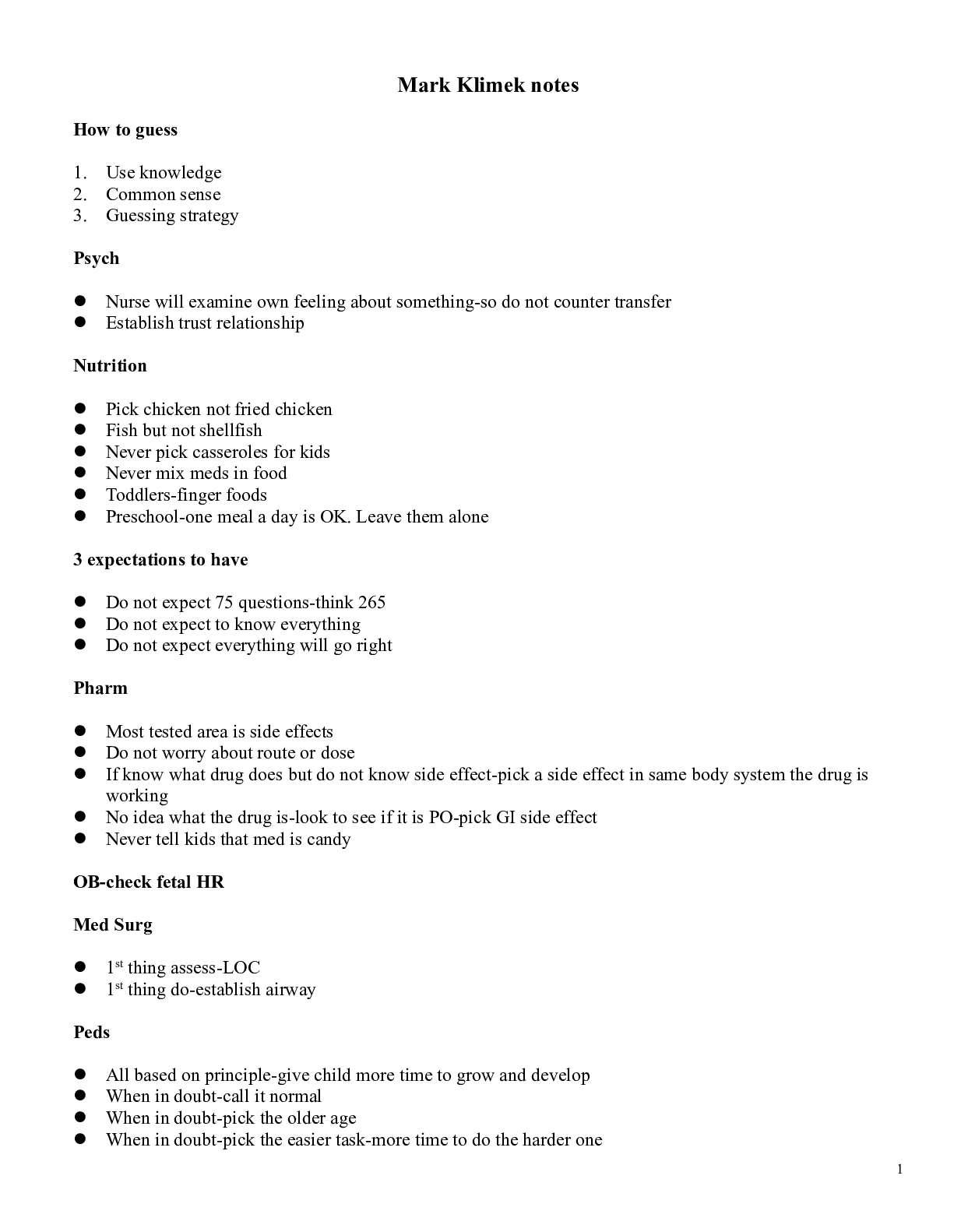
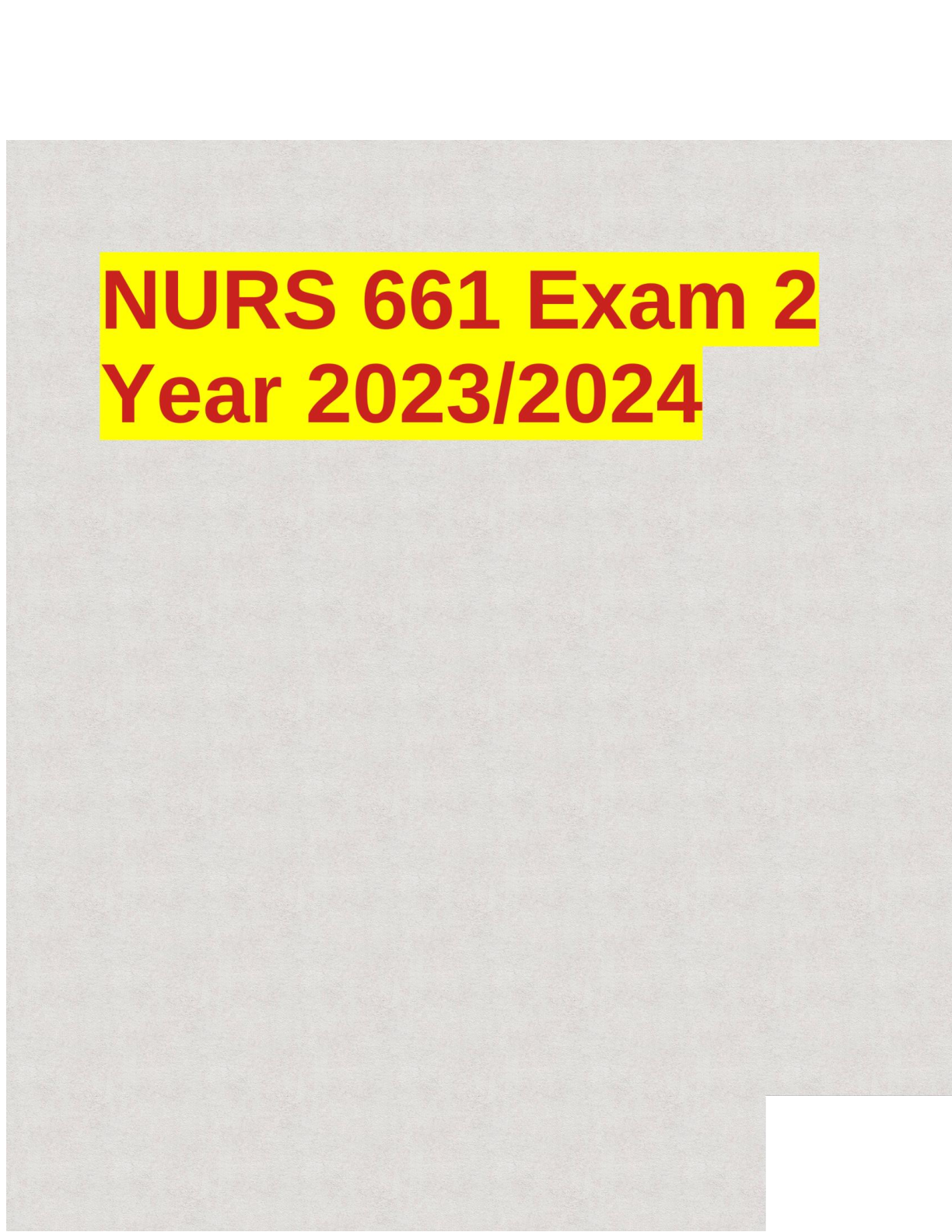
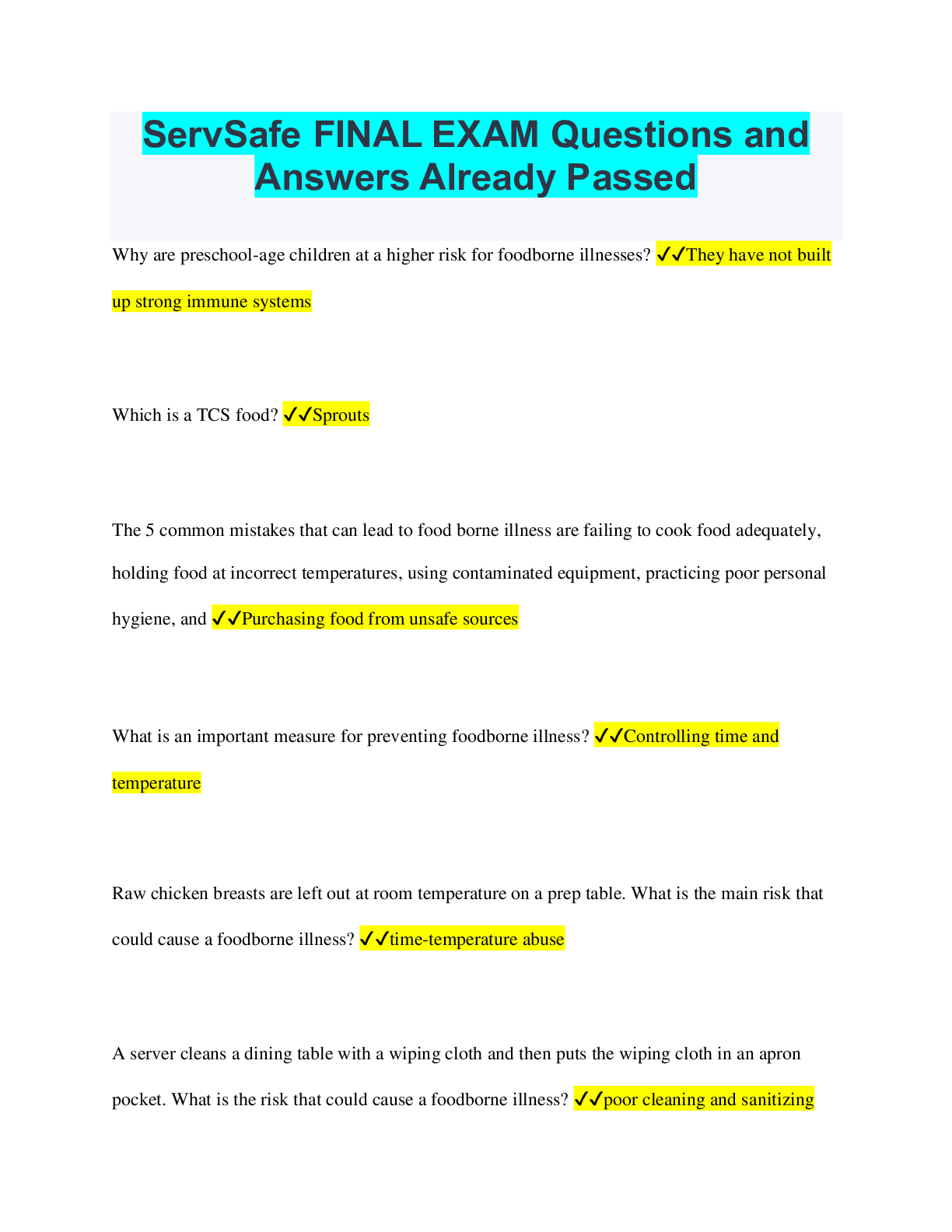

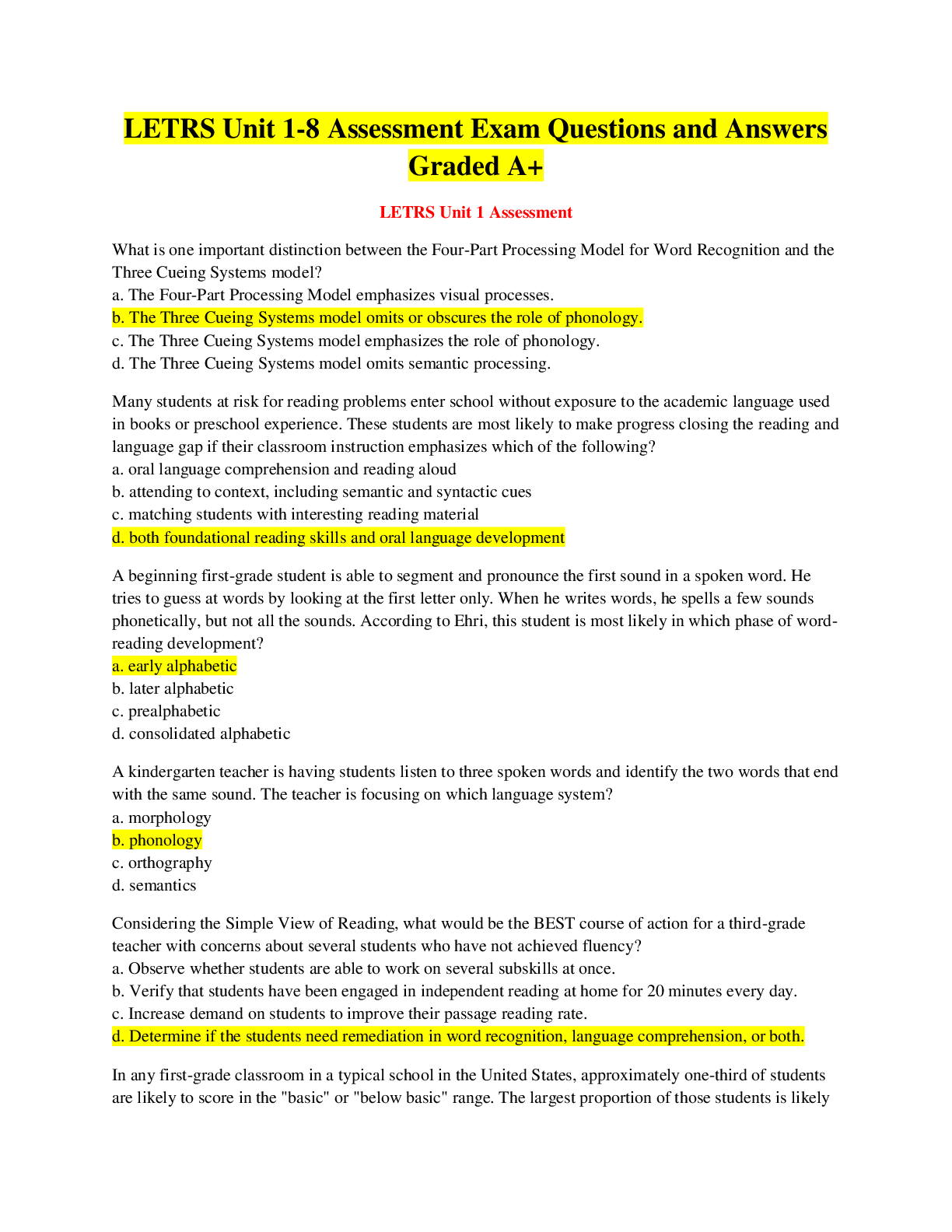

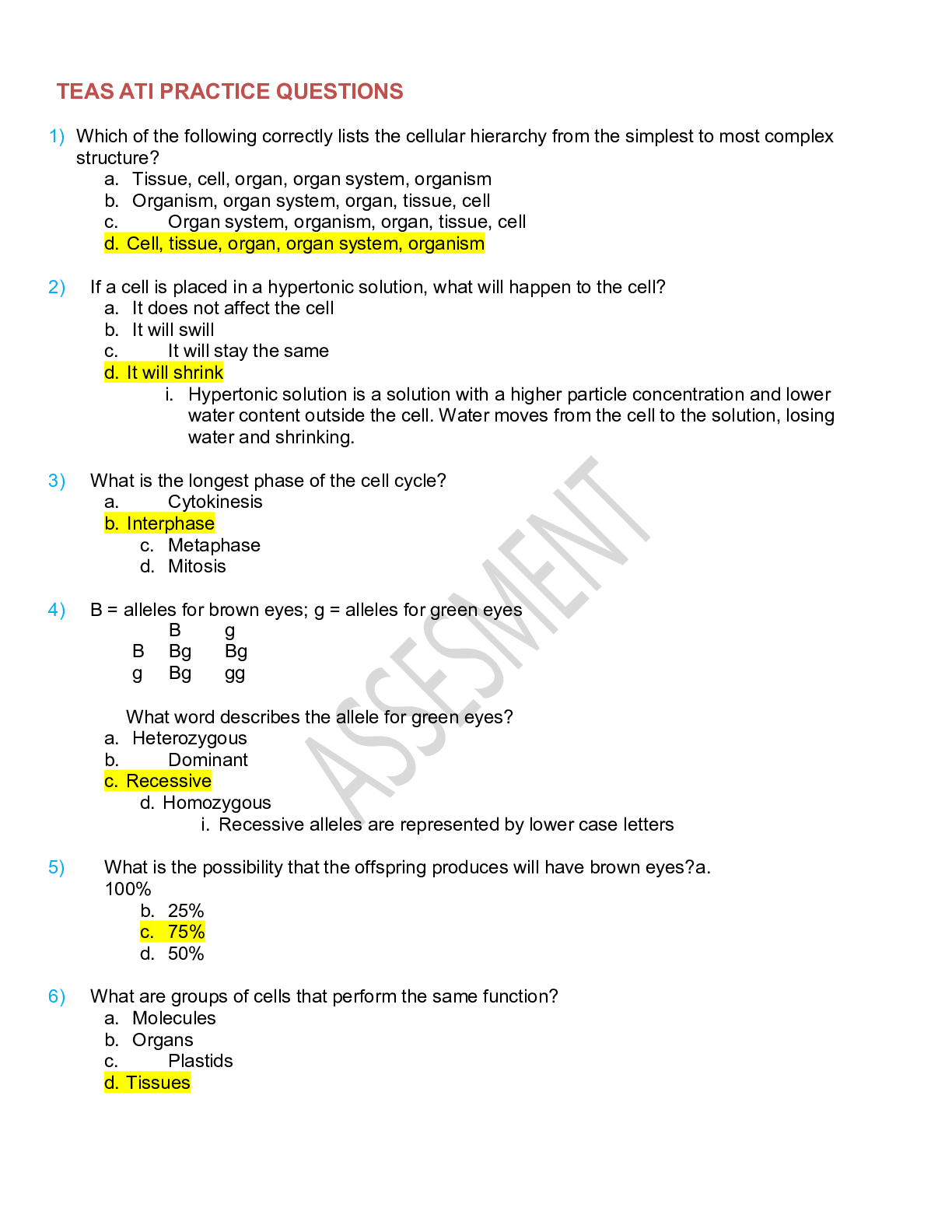
 – Chamberlain College of Nursing.png)
